

Assignment Guides
Educ 8112 module 2 assignment 2: module 2 assignment 2, assignment description.
For Module 2, Assignment 2, you will find articles and create a bibliography, including a 1 1/2 - 2 page annotation for one article.
This guide covers some strategies you can use to search for articles on your topic:
Select search keywords
Build a search in the library databases, identify research studies (empirical articles), create your bibliography.
For each of your research topics, you'll want to start by building a list of keywords that you can use for your search.
Keywords need to match the words that authors have used when writing articles on that topic. You'll want to pick words that you would expect to see in an article's title or abstract. This will help you get the most relevant articles at the top of your results list.
Here is an example of a topic and possible keywords:
Focus on the main concepts, avoiding words that are vague or implied. For example, using a general term like "affect" can greatly limit your results. First, an author may only use words for a single, specific effect (e.g. technology use raises student achievement). Second, there are many alternative phrasings that can look at the effects of something (e.g. impact, result, consequence, etc.), and it's unlikely you'll be able to brainstorm them all. You'll get better results if you brainstorm specific effects (e.g. academic achievement) instead of using "affect/effect" as a keyword.
The term l ow income might look incomplete, but it captures low-income student, low-income family, low-income household, etc. Likewise, you might instead use simply success or achievement.
Learn more about keyword searching.
The next step is to use your keywords to build a search within a library database. While each database has a unique collection, and may look slightly different, these general steps will work in every library database.
Below is an example search using the keywords provided in the box above.
1. From the library website , look for the Subject Resources box and click on the Select a subject drop-down:

2. Click the Education option. Now you will see the Education Research guide. This guide has links to the databases used most often for Education research.
3. Select a database. This search example uses ERIC, one of our Education subject databases. Scroll down to the Education Databases box. Click the ERIC link. You may need to log in with your myWalden user name and password.
4. Type your keywords into the search boxes. Place keywords for a single concept into one box, using "or" between each one. This tells the database to find articles that have any of those terms.
For example, first search box:
digital divide or technology or internet
Second search box:
academic achievement or student achievement or student success
Third search box:
poverty or poor or low income

Learn more about "or" and other Boolean operators.
5. Add limits to your search. The limits you choose will depend on what you need to find. Check the Scholarly Peer-Reviewed box , if the database you are using includes the option. You can also add a date limit .
Learn more about database limiters

Click to see a larger image of this search page.
6. Click the Search button . See if the articles are relevant by reading titles and abstracts.
Learn about identifying original research studies (the next box down).
7. Refine your search if you need to improve your results.
One way to refine a search is to explore the Subjects (available in ERIC and Education Source) for alternative keywords. Subjects are the official, preferred terms for concepts within a database. If you search using these terms, you will find more precise results. They can also give you ideas for aspects you haven't considered.

Add these terms to your search or use them instead of your original keywords.
Learn more about using subject terms.
Education Databases
After a search, read article titles and abstracts to see if they address your topic and look for indications that the author(s) conducted original research. Click the article title to see the abstract.
Some abstracts clearly identify the major components of an original research study:

Other abstracts are less structured but still readily indicate whether it's a research study:

Your Assignment and Module 2 Resources pages in your course include references to more information about identifying empirical research.
The final step of the assignment is to create the bibliography and write your annotation for one of the articles.
APA Citations
All citations will need to be created using the rules in the APA's 6th edition manual. Here are some resources that can help you create/edit your citations:
- Citing Electronic Articles
- Common Reference List Examples
- How do I find a DOI?
- How do I cite an article without a DOI?
Writing Your Annotation
Your assignment has specific requirements for each paragraph of the annotation you will be writing. The following resources may help you with the writing portion of your assignment:
- What is Grammarly?
- Grammar Help
- Scholarly Voice
- Next Page: Return to EDUC 8112 Course Guide
- Office of Student Disability Services
Walden Resources
Departments.
- Academic Residencies
- Academic Skills
- Career Planning and Development
- Customer Care Team
- Field Experience
- Military Services
- Student Success Advising
- Writing Skills
Centers and Offices
- Center for Social Change
- Office of Academic Support and Instructional Services
- Office of Degree Acceleration
- Office of Research and Doctoral Services
- Office of Student Affairs
Student Resources
- Doctoral Writing Assessment
- Form & Style Review
- Quick Answers
- ScholarWorks
- SKIL Courses and Workshops
- Walden Bookstore
- Walden Catalog & Student Handbook
- Student Safety/Title IX
- Legal & Consumer Information
- Website Terms and Conditions
- Cookie Policy
- Accessibility
- Accreditation
- State Authorization
- Net Price Calculator
- Contact Walden
Walden University is a member of Adtalem Global Education, Inc. www.adtalem.com Walden University is certified to operate by SCHEV © 2024 Walden University LLC. All rights reserved.
How to Write a Perfect Assignment: Step-By-Step Guide
Table of contents
- 1 How to Structure an Assignment?
- 2.1 The research part
- 2.2 Planning your text
- 2.3 Writing major parts
- 3 Expert Tips for your Writing Assignment
- 4 Will I succeed with my assignments?
- 5 Conclusion
How to Structure an Assignment?
To cope with assignments, you should familiarize yourself with the tips on formatting and presenting assignments or any written paper, which are given below. It is worth paying attention to the content of the paper, making it structured and understandable so that ideas are not lost and thoughts do not refute each other.
If the topic is free or you can choose from the given list — be sure to choose the one you understand best. Especially if that could affect your semester score or scholarship. It is important to select an engaging title that is contextualized within your topic. A topic that should captivate you or at least give you a general sense of what is needed there. It’s easier to dwell upon what interests you, so the process goes faster.
To construct an assignment structure, use outlines. These are pieces of text that relate to your topic. It can be ideas, quotes, all your thoughts, or disparate arguments. Type in everything that you think about. Separate thoughts scattered across the sheets of Word will help in the next step.
Then it is time to form the text. At this stage, you have to form a coherent story from separate pieces, where each new thought reinforces the previous one, and one idea smoothly flows into another.
Main Steps of Assignment Writing
These are steps to take to get a worthy paper. If you complete these step-by-step, your text will be among the most exemplary ones.
The research part
If the topic is unique and no one has written about it yet, look at materials close to this topic to gain thoughts about it. You should feel that you are ready to express your thoughts. Also, while reading, get acquainted with the format of the articles, study the details, collect material for your thoughts, and accumulate different points of view for your article. Be careful at this stage, as the process can help you develop your ideas. If you are already struggling here, pay for assignment to be done , and it will be processed in a split second via special services. These services are especially helpful when the deadline is near as they guarantee fast delivery of high-quality papers on any subject.
If you use Google to search for material for your assignment, you will, of course, find a lot of information very quickly. Still, the databases available on your library’s website will give you the clearest and most reliable facts that satisfy your teacher or professor. Be sure you copy the addresses of all the web pages you will use when composing your paper, so you don’t lose them. You can use them later in your bibliography if you add a bit of description! Select resources and extract quotes from them that you can use while working. At this stage, you may also create a request for late assignment if you realize the paper requires a lot of effort and is time-consuming. This way, you’ll have a backup plan if something goes wrong.
Planning your text
Assemble a layout. It may be appropriate to use the structure of the paper of some outstanding scientists in your field and argue it in one of the parts. As the planning progresses, you can add suggestions that come to mind. If you use citations that require footnotes, and if you use single spacing throughout the paper and double spacing at the end, it will take you a very long time to make sure that all the citations are on the exact pages you specified! Add a reference list or bibliography. If you haven’t already done so, don’t put off writing an essay until the last day. It will be more difficult to do later as you will be stressed out because of time pressure.
Writing major parts
It happens that there is simply no mood or strength to get started and zero thoughts. In that case, postpone this process for 2-3 hours, and, perhaps, soon, you will be able to start with renewed vigor. Writing essays is a great (albeit controversial) way to improve your skills. This experience will not be forgotten. It will certainly come in handy and bring many benefits in the future. Do your best here because asking for an extension is not always possible, so you probably won’t have time to redo it later. And the quality of this part defines the success of the whole paper.
Writing the major part does not mean the matter is finished. To review the text, make sure that the ideas of the introduction and conclusion coincide because such a discrepancy is the first thing that will catch the reader’s eye and can spoil the impression. Add or remove anything from your intro to edit it to fit the entire paper. Also, check your spelling and grammar to ensure there are no typos or draft comments. Check the sources of your quotes so that your it is honest and does not violate any rules. And do not forget the formatting rules.
with the right tips and guidance, it can be easier than it looks. To make the process even more straightforward, students can also use an assignment service to get the job done. This way they can get professional assistance and make sure that their assignments are up to the mark. At PapersOwl, we provide a professional writing service where students can order custom-made assignments that meet their exact requirements.
Expert Tips for your Writing Assignment
Want to write like a pro? Here’s what you should consider:
- Save the document! Send the finished document by email to yourself so you have a backup copy in case your computer crashes.
- Don’t wait until the last minute to complete a list of citations or a bibliography after the paper is finished. It will be much longer and more difficult, so add to them as you go.
- If you find a lot of information on the topic of your search, then arrange it in a separate paragraph.
- If possible, choose a topic that you know and are interested in.
- Believe in yourself! If you set yourself up well and use your limited time wisely, you will be able to deliver the paper on time.
- Do not copy information directly from the Internet without citing them.
Writing assignments is a tedious and time-consuming process. It requires a lot of research and hard work to produce a quality paper. However, if you are feeling overwhelmed or having difficulty understanding the concept, you may want to consider getting accounting homework help online . Professional experts can assist you in understanding how to complete your assignment effectively. PapersOwl.com offers expert help from highly qualified and experienced writers who can provide you with the homework help you need.
Will I succeed with my assignments?
Anyone can learn how to be good at writing: follow simple rules of creating the structure and be creative where it is appropriate. At one moment, you will need some additional study tools, study support, or solid study tips. And you can easily get help in writing assignments or any other work. This is especially useful since the strategy of learning how to write an assignment can take more time than a student has.
Therefore all students are happy that there is an option to order your paper at a professional service to pass all the courses perfectly and sleep still at night. You can also find the sample of the assignment there to check if you are on the same page and if not — focus on your papers more diligently.
So, in the times of studies online, the desire and skill to research and write may be lost. Planning your assignment carefully and presenting arguments step-by-step is necessary to succeed with your homework. When going through your references, note the questions that appear and answer them, building your text. Create a cover page, proofread the whole text, and take care of formatting. Feel free to use these rules for passing your next assignments.
When it comes to writing an assignment, it can be overwhelming and stressful, but Papersowl is here to make it easier for you. With a range of helpful resources available, Papersowl can assist you in creating high-quality written work, regardless of whether you’re starting from scratch or refining an existing draft. From conducting research to creating an outline, and from proofreading to formatting, the team at Papersowl has the expertise to guide you through the entire writing process and ensure that your assignment meets all the necessary requirements.
Readers also enjoyed

WHY WAIT? PLACE AN ORDER RIGHT NOW!
Just fill out the form, press the button, and have no worries!
We use cookies to give you the best experience possible. By continuing we’ll assume you board with our cookie policy.

Want to create or adapt books like this? Learn more about how Pressbooks supports open publishing practices.
Writing Assignments
Kate Derrington; Cristy Bartlett; and Sarah Irvine

Introduction
Assignments are a common method of assessment at university and require careful planning and good quality research. Developing critical thinking and writing skills are also necessary to demonstrate your ability to understand and apply information about your topic. It is not uncommon to be unsure about the processes of writing assignments at university.
- You may be returning to study after a break
- You may have come from an exam based assessment system and never written an assignment before
- Maybe you have written assignments but would like to improve your processes and strategies
This chapter has a collection of resources that will provide you with the skills and strategies to understand assignment requirements and effectively plan, research, write and edit your assignments. It begins with an explanation of how to analyse an assignment task and start putting your ideas together. It continues by breaking down the components of academic writing and exploring the elements you will need to master in your written assignments. This is followed by a discussion of paraphrasing and synthesis, and how you can use these strategies to create a strong, written argument. The chapter concludes with useful checklists for editing and proofreading to help you get the best possible mark for your work.
Task Analysis and Deconstructing an Assignment
It is important that before you begin researching and writing your assignments you spend sufficient time understanding all the requirements. This will help make your research process more efficient and effective. Check your subject information such as task sheets, criteria sheets and any additional information that may be in your subject portal online. Seek clarification from your lecturer or tutor if you are still unsure about how to begin your assignments.
The task sheet typically provides key information about an assessment including the assignment question. It can be helpful to scan this document for topic, task and limiting words to ensure that you fully understand the concepts you are required to research, how to approach the assignment, and the scope of the task you have been set. These words can typically be found in your assignment question and are outlined in more detail in the two tables below (see Table 19.1 and Table 19.2 ).
Table 19.1 Parts of an Assignment Question
Make sure you have a clear understanding of what the task word requires you to address.
Table 19.2 Task words
The criteria sheet , also known as the marking sheet or rubric, is another important document to look at before you begin your assignment. The criteria sheet outlines how your assignment will be marked and should be used as a checklist to make sure you have included all the information required.
The task or criteria sheet will also include the:
- Word limit (or word count)
- Referencing style and research expectations
- Formatting requirements
Task analysis and criteria sheets are also discussed in the chapter Managing Assessments for a more detailed discussion on task analysis, criteria sheets, and marking rubrics.
Preparing your ideas

Brainstorm or concept map: List possible ideas to address each part of the assignment task based on what you already know about the topic from lectures and weekly readings.
Finding appropriate information: Learn how to find scholarly information for your assignments which is
See the chapter Working With Information for a more detailed explanation .
What is academic writing?
Academic writing tone and style.
Many of the assessment pieces you prepare will require an academic writing style. This is sometimes called ‘academic tone’ or ‘academic voice’. This section will help you to identify what is required when you are writing academically (see Table 19.3 ). The best way to understand what academic writing looks like, is to read broadly in your discipline area. Look at how your course readings, or scholarly sources, are written. This will help you identify the language of your discipline field, as well as how other writers structure their work.
Table 19.3 Comparison of academic and non-academic writing
Thesis statements.
Essays are a common form of assessment that you will likely encounter during your university studies. You should apply an academic tone and style when writing an essay, just as you would in in your other assessment pieces. One of the most important steps in writing an essay is constructing your thesis statement. A thesis statement tells the reader the purpose, argument or direction you will take to answer your assignment question. A thesis statement may not be relevant for some questions, if you are unsure check with your lecturer. The thesis statement:
- Directly relates to the task . Your thesis statement may even contain some of the key words or synonyms from the task description.
- Does more than restate the question.
- Is specific and uses precise language.
- Let’s your reader know your position or the main argument that you will support with evidence throughout your assignment.
- The subject is the key content area you will be covering.
- The contention is the position you are taking in relation to the chosen content.
Your thesis statement helps you to structure your essay. It plays a part in each key section: introduction, body and conclusion.
Planning your assignment structure

When planning and drafting assignments, it is important to consider the structure of your writing. Academic writing should have clear and logical structure and incorporate academic research to support your ideas. It can be hard to get started and at first you may feel nervous about the size of the task, this is normal. If you break your assignment into smaller pieces, it will seem more manageable as you can approach the task in sections. Refer to your brainstorm or plan. These ideas should guide your research and will also inform what you write in your draft. It is sometimes easier to draft your assignment using the 2-3-1 approach, that is, write the body paragraphs first followed by the conclusion and finally the introduction.
Writing introductions and conclusions
Clear and purposeful introductions and conclusions in assignments are fundamental to effective academic writing. Your introduction should tell the reader what is going to be covered and how you intend to approach this. Your conclusion should summarise your argument or discussion and signal to the reader that you have come to a conclusion with a final statement. These tips below are based on the requirements usually needed for an essay assignment, however, they can be applied to other assignment types.
Writing introductions

Most writing at university will require a strong and logically structured introduction. An effective introduction should provide some background or context for your assignment, clearly state your thesis and include the key points you will cover in the body of the essay in order to prove your thesis.
Usually, your introduction is approximately 10% of your total assignment word count. It is much easier to write your introduction once you have drafted your body paragraphs and conclusion, as you know what your assignment is going to be about. An effective introduction needs to inform your reader by establishing what the paper is about and provide four basic things:
- A brief background or overview of your assignment topic
- A thesis statement (see section above)
- An outline of your essay structure
- An indication of any parameters or scope that will/ will not be covered, e.g. From an Australian perspective.
The below example demonstrates the four different elements of an introductory paragraph.
1) Information technology is having significant effects on the communication of individuals and organisations in different professions. 2) This essay will discuss the impact of information technology on the communication of health professionals. 3) First, the provision of information technology for the educational needs of nurses will be discussed. 4) This will be followed by an explanation of the significant effects that information technology can have on the role of general practitioner in the area of public health. 5) Considerations will then be made regarding the lack of knowledge about the potential of computers among hospital administrators and nursing executives. 6) The final section will explore how information technology assists health professionals in the delivery of services in rural areas . 7) It will be argued that information technology has significant potential to improve health care and medical education, but health professionals are reluctant to use it.
1 Brief background/ overview | 2 Indicates the scope of what will be covered | 3-6 Outline of the main ideas (structure) | 7 The thesis statement
Note : The examples in this document are taken from the University of Canberra and used under a CC-BY-SA-3.0 licence.
Writing conclusions
You should aim to end your assignments with a strong conclusion. Your conclusion should restate your thesis and summarise the key points you have used to prove this thesis. Finish with a key point as a final impactful statement. Similar to your introduction, your conclusion should be approximately 10% of the total assignment word length. If your assessment task asks you to make recommendations, you may need to allocate more words to the conclusion or add a separate recommendations section before the conclusion. Use the checklist below to check your conclusion is doing the right job.
Conclusion checklist
- Have you referred to the assignment question and restated your argument (or thesis statement), as outlined in the introduction?
- Have you pulled together all the threads of your essay into a logical ending and given it a sense of unity?
- Have you presented implications or recommendations in your conclusion? (if required by your task).
- Have you added to the overall quality and impact of your essay? This is your final statement about this topic; thus, a key take-away point can make a great impact on the reader.
- Remember, do not add any new material or direct quotes in your conclusion.
This below example demonstrates the different elements of a concluding paragraph.
1) It is evident, therefore, that not only do employees need to be trained for working in the Australian multicultural workplace, but managers also need to be trained. 2) Managers must ensure that effective in-house training programs are provided for migrant workers, so that they become more familiar with the English language, Australian communication norms and the Australian work culture. 3) In addition, Australian native English speakers need to be made aware of the differing cultural values of their workmates; particularly the different forms of non-verbal communication used by other cultures. 4) Furthermore, all employees must be provided with clear and detailed guidelines about company expectations. 5) Above all, in order to minimise communication problems and to maintain an atmosphere of tolerance, understanding and cooperation in the multicultural workplace, managers need to have an effective knowledge about their employees. This will help employers understand how their employee’s social conditioning affects their beliefs about work. It will develop their communication skills to develop confidence and self-esteem among diverse work groups. 6) The culturally diverse Australian workplace may never be completely free of communication problems, however, further studies to identify potential problems and solutions, as well as better training in cross cultural communication for managers and employees, should result in a much more understanding and cooperative environment.
1 Reference to thesis statement – In this essay the writer has taken the position that training is required for both employees and employers . | 2-5 Structure overview – Here the writer pulls together the main ideas in the essay. | 6 Final summary statement that is based on the evidence.
Note: The examples in this document are taken from the University of Canberra and used under a CC-BY-SA-3.0 licence.
Writing paragraphs
Paragraph writing is a key skill that enables you to incorporate your academic research into your written work. Each paragraph should have its own clearly identified topic sentence or main idea which relates to the argument or point (thesis) you are developing. This idea should then be explained by additional sentences which you have paraphrased from good quality sources and referenced according to the recommended guidelines of your subject (see the chapter Working with Information ). Paragraphs are characterised by increasing specificity; that is, they move from the general to the specific, increasingly refining the reader’s understanding. A common structure for paragraphs in academic writing is as follows.
Topic Sentence
This is the main idea of the paragraph and should relate to the overall issue or purpose of your assignment is addressing. Often it will be expressed as an assertion or claim which supports the overall argument or purpose of your writing.
Explanation/ Elaboration
The main idea must have its meaning explained and elaborated upon. Think critically, do not just describe the idea.
These explanations must include evidence to support your main idea. This information should be paraphrased and referenced according to the appropriate referencing style of your course.
Concluding sentence (critical thinking)
This should explain why the topic of the paragraph is relevant to the assignment question and link to the following paragraph.
Use the checklist below to check your paragraphs are clear and well formed.
Paragraph checklist
- Does your paragraph have a clear main idea?
- Is everything in the paragraph related to this main idea?
- Is the main idea adequately developed and explained?
- Do your sentences run together smoothly?
- Have you included evidence to support your ideas?
- Have you concluded the paragraph by connecting it to your overall topic?
Writing sentences
Make sure all the sentences in your paragraphs make sense. Each sentence must contain a verb to be a complete sentence. Avoid sentence fragments . These are incomplete sentences or ideas that are unfinished and create confusion for your reader. Avoid also run on sentences . This happens when you join two ideas or clauses without using the appropriate punctuation. This also confuses your meaning (See the chapter English Language Foundations for examples and further explanation).
Use transitions (linking words and phrases) to connect your ideas between paragraphs and make your writing flow. The order that you structure the ideas in your assignment should reflect the structure you have outlined in your introduction. Refer to transition words table in the chapter English Language Foundations.
Paraphrasing and Synthesising
Paraphrasing and synthesising are powerful tools that you can use to support the main idea of a paragraph. It is likely that you will regularly use these skills at university to incorporate evidence into explanatory sentences and strengthen your essay. It is important to paraphrase and synthesise because:
- Paraphrasing is regarded more highly at university than direct quoting.
- Paraphrasing can also help you better understand the material.
- Paraphrasing and synthesising demonstrate you have understood what you have read through your ability to summarise and combine arguments from the literature using your own words.
What is paraphrasing?
Paraphrasing is changing the writing of another author into your words while retaining the original meaning. You must acknowledge the original author as the source of the information in your citation. Follow the steps in this table to help you build your skills in paraphrasing (see Table 19.4 ).
Table 19.4 Paraphrasing techniques
Example of paraphrasing.
Please note that these examples and in text citations are for instructional purposes only.
Original text
Health care professionals assist people often when they are at their most vulnerable . To provide the best care and understand their needs, workers must demonstrate good communication skills . They must develop patient trust and provide empathy to effectively work with patients who are experiencing a variety of situations including those who may be suffering from trauma or violence, physical or mental illness or substance abuse (French & Saunders, 2018).
Poor quality paraphrase example
This is a poor example of paraphrasing. Some synonyms have been used and the order of a few words changed within the sentences however the colours of the sentences indicate that the paragraph follows the same structure as the original text.
Health care sector workers are often responsible for vulnerable patients. To understand patients and deliver good service , they need to be excellent communicators . They must establish patient rapport and show empathy if they are to successfully care for patients from a variety of backgrounds and with different medical, psychological and social needs (French & Saunders, 2018).
A good quality paraphrase example
This example demonstrates a better quality paraphrase. The author has demonstrated more understanding of the overall concept in the text by using the keywords as the basis to reconstruct the paragraph. Note how the blocks of colour have been broken up to see how much the structure has changed from the original text.
Empathetic communication is a vital skill for health care workers. Professionals in these fields are often responsible for patients with complex medical, psychological and social needs. Empathetic communication assists in building rapport and gaining the necessary trust to assist these vulnerable patients by providing appropriate supportive care (French & Saunders, 2018).
The good quality paraphrase example demonstrates understanding of the overall concept in the text by using key words as the basis to reconstruct the paragraph. Note how the blocks of colour have been broken up, which indicates how much the structure has changed from the original text.
What is synthesising?
Synthesising means to bring together more than one source of information to strengthen your argument. Once you have learnt how to paraphrase the ideas of one source at a time, you can consider adding additional sources to support your argument. Synthesis demonstrates your understanding and ability to show connections between multiple pieces of evidence to support your ideas and is a more advanced academic thinking and writing skill.
Follow the steps in this table to improve your synthesis techniques (see Table 19.5 ).
Table 19.5 Synthesising techniques
Example of synthesis
There is a relationship between academic procrastination and mental health outcomes. Procrastination has been found to have a negative effect on students’ well-being (Balkis, & Duru, 2016). Yerdelen, McCaffrey, and Klassens’ (2016) research results suggested that there was a positive association between procrastination and anxiety. This was corroborated by Custer’s (2018) findings which indicated that students with higher levels of procrastination also reported greater levels of the anxiety. Therefore, it could be argued that procrastination is an ineffective learning strategy that leads to increased levels of distress.
Topic sentence | Statements using paraphrased evidence | Critical thinking (student voice) | Concluding statement – linking to topic sentence
This example demonstrates a simple synthesis. The author has developed a paragraph with one central theme and included explanatory sentences complete with in-text citations from multiple sources. Note how the blocks of colour have been used to illustrate the paragraph structure and synthesis (i.e., statements using paraphrased evidence from several sources). A more complex synthesis may include more than one citation per sentence.
Creating an argument
What does this mean.
Throughout your university studies, you may be asked to ‘argue’ a particular point or position in your writing. You may already be familiar with the idea of an argument, which in general terms means to have a disagreement with someone. Similarly, in academic writing, if you are asked to create an argument, this means you are asked to have a position on a particular topic, and then justify your position using evidence.
What skills do you need to create an argument?
In order to create a good and effective argument, you need to be able to:
- Read critically to find evidence
- Plan your argument
- Think and write critically throughout your paper to enhance your argument
For tips on how to read and write critically, refer to the chapter Thinking for more information. A formula for developing a strong argument is presented below.
A formula for a good argument

What does an argument look like?
As can be seen from the figure above, including evidence is a key element of a good argument. While this may seem like a straightforward task, it can be difficult to think of wording to express your argument. The table below provides examples of how you can illustrate your argument in academic writing (see Table 19.6 ).
Table 19.6 Argument
Editing and proofreading (reviewing).
Once you have finished writing your first draft it is recommended that you spend time revising your work. Proofreading and editing are two different stages of the revision process.
- Editing considers the overall focus or bigger picture of the assignment
- Proofreading considers the finer details

As can be seen in the figure above there are four main areas that you should review during the editing phase of the revision process. The main things to consider when editing include content, structure, style, and sources. It is important to check that all the content relates to the assignment task, the structure is appropriate for the purposes of the assignment, the writing is academic in style, and that sources have been adequately acknowledged. Use the checklist below when editing your work.
Editing checklist
- Have I answered the question accurately?
- Do I have enough credible, scholarly supporting evidence?
- Is my writing tone objective and formal enough or have I used emotive and informal language?
- Have I written in the third person not the first person?
- Do I have appropriate in-text citations for all my information?
- Have I included the full details for all my in-text citations in my reference list?
There are also several key things to look out for during the proofreading phase of the revision process. In this stage it is important to check your work for word choice, grammar and spelling, punctuation and referencing errors. It can be easy to mis-type words like ‘from’ and ‘form’ or mix up words like ‘trail’ and ‘trial’ when writing about research, apply American rather than Australian spelling, include unnecessary commas or incorrectly format your references list. The checklist below is a useful guide that you can use when proofreading your work.
Proofreading checklist
- Is my spelling and grammar accurate?
- Are they complete?
- Do they all make sense?
- Do they only contain only one idea?
- Do the different elements (subject, verb, nouns, pronouns) within my sentences agree?
- Are my sentences too long and complicated?
- Do they contain only one idea per sentence?
- Is my writing concise? Take out words that do not add meaning to your sentences.
- Have I used appropriate discipline specific language but avoided words I don’t know or understand that could possibly be out of context?
- Have I avoided discriminatory language and colloquial expressions (slang)?
- Is my referencing formatted correctly according to my assignment guidelines? (for more information on referencing refer to the Managing Assessment feedback section).
This chapter has examined the experience of writing assignments. It began by focusing on how to read and break down an assignment question, then highlighted the key components of essays. Next, it examined some techniques for paraphrasing and summarising, and how to build an argument. It concluded with a discussion on planning and structuring your assignment and giving it that essential polish with editing and proof-reading. Combining these skills and practising them, can greatly improve your success with this very common form of assessment.
- Academic writing requires clear and logical structure, critical thinking and the use of credible scholarly sources.
- A thesis statement is important as it tells the reader the position or argument you have adopted in your assignment. Not all assignments will require a thesis statement.
- Spending time analysing your task and planning your structure before you start to write your assignment is time well spent.
- Information you use in your assignment should come from credible scholarly sources such as textbooks and peer reviewed journals. This information needs to be paraphrased and referenced appropriately.
- Paraphrasing means putting something into your own words and synthesising means to bring together several ideas from sources.
- Creating an argument is a four step process and can be applied to all types of academic writing.
- Editing and proofreading are two separate processes.
Academic Skills Centre. (2013). Writing an introduction and conclusion . University of Canberra, accessed 13 August, 2013, http://www.canberra.edu.au/studyskills/writing/conclusions
Balkis, M., & Duru, E. (2016). Procrastination, self-regulation failure, academic life satisfaction, and affective well-being: underregulation or misregulation form. European Journal of Psychology of Education, 31 (3), 439-459.
Custer, N. (2018). Test anxiety and academic procrastination among prelicensure nursing students. Nursing education perspectives, 39 (3), 162-163.
Yerdelen, S., McCaffrey, A., & Klassen, R. M. (2016). Longitudinal examination of procrastination and anxiety, and their relation to self-efficacy for self-regulated learning: Latent growth curve modeling. Educational Sciences: Theory & Practice, 16 (1).
Writing Assignments Copyright © 2021 by Kate Derrington; Cristy Bartlett; and Sarah Irvine is licensed under a Creative Commons Attribution-ShareAlike 4.0 International License , except where otherwise noted.
Share This Book
Assignments usually ask you to demonstrate that you have immersed yourself in the course material and that you've done some thinking on your own; questions not treated at length in class often serve as assignments. Fortunately, if you've put the time into getting to know the material, then you've almost certainly begun thinking independently. In responding to assignments, keep in mind the following advice.
- Beware of straying. Especially in the draft stage, "discussion" and "analysis" can lead you from one intrinsically interesting problem to another, then another, and then ... You may wind up following a garden of forking paths and lose your way. To prevent this, stop periodically while drafting your essay and reread the assignment. Its purposes are likely to become clearer.
- Consider the assignment in relation to previous and upcoming assignments. Ask yourself what is new about the task you're setting out to do. Instructors often design assignments to build in complexity. Knowing where an assignment falls in this progression can help you concentrate on the specific, fresh challenges at hand.
Understanding some key words commonly used in assignments also may simplify your task. Toward this end, let's take a look at two seemingly impenetrable instructions: "discuss" and "analyze."
1. Discuss the role of gender in bringing about the French Revolution.
- "Discuss" is easy to misunderstand because the word calls to mind the oral/spoken dimension of communication. "Discuss" suggests conversation, which often is casual and undirected. In the context of an assignment, however, discussion entails fulfilling a defined and organized task: to construct an argument that considers and responds to an ample range of materials. To "discuss," in assignment language, means to make a broad argument about a set of arguments you have studied. In the case above, you can do this by
- pointing to consistencies and inconsistencies in the evidence of gendered causes of the Revolution;
- raising the implications of these consistencies and/or inconsistencies (perhaps they suggest a limited role for gender as catalyst);
- evaluating different claims about the role of gender; and
- asking what is gained and what is lost by focusing on gendered symbols, icons and events.
A weak discussion essay in response to the question above might simply list a few aspects of the Revolution—the image of Liberty, the executions of the King and Marie Antoinette, the cry "Liberte, Egalite, Fraternite!" —and make separate comments about how each, being "gendered," is therefore a powerful political force. Such an essay would offer no original thesis, but instead restate the question asked in the assignment (i.e., "The role of gender was very important in the French Revolution" or "Gender did not play a large role in the French Revolution").
In a strong discussion essay, the thesis would go beyond a basic restatement of the assignment question. You might test the similarities and differences of the revolutionary aspects being discussed. You might draw on fresh or unexpected evidence, perhaps using as a source an intriguing reading that was only briefly touched upon in lecture.
2. Analyze two of Chaucer's Canterbury Tales, including one not discussed in class, as literary works and in terms of sources/analogues.
The words "analyze" and "analysis" may seem to denote highly advanced, even arcane skills, possessed in virtual monopoly by mathematicians and scientists. Happily, the terms refer to mental activity we all perform regularly; the terms just need decoding. "Analyze" means two things in this specific assignment prompt.
- First, you need to divide the two tales into parts, elements, or features. You might start with a basic approach: looking at the beginning, middle, and end. These structural features of literary works—and of historical events and many other subjects of academic study—may seem simple or even simplistic, but they can yield surprising insights when examined closely.
- Alternatively, you might begin at a more complex level of analysis. For example, you might search for and distinguish between kinds of humor in the two tales and their sources in Boccaccio or the Roman de la Rose: banter, wordplay, bawdy jokes, pranks, burlesque, satire, etc.
Second, you need to consider the two tales critically to arrive at some reward for having observed how the tales are made and where they came from (their sources/analogues). In the course of your essay, you might work your way to investigating Chaucer's broader attitude toward his sources, which alternates between playful variation and strict adherence. Your complex analysis of kinds of humor might reveal differing conceptions of masculine and feminine between Chaucer and his literary sources, or some other important cultural distinction.
Analysis involves both a set of observations about the composition or workings of your subject and a critical approach that keeps you from noticing just anything—from excessive listing or summarizing—and instead leads you to construct an interpretation, using textual evidence to support your ideas.
Some Final Advice
If, having read the assignment carefully, you're still confused by it, don't hesitate to ask for clarification from your instructor. He or she may be able to elucidate the question or to furnish some sample responses to the assignment. Knowing the expectations of an assignment can help when you're feeling puzzled. Conversely, knowing the boundaries can head off trouble if you're contemplating an unorthodox approach. In either case, before you go to your instructor, it's a good idea to list, underline or circle the specific places in the assignment where the language makes you feel uncertain.
William C. Rice, for the Writing Center at Harvard University
How To Make A Cover Page For An Assignment? An Ultimate Guide
Link Copied
Share on Facebook
Share on Twitter
Share on LinkedIn

Level Up Your Assignment Game!
What if you made a shiny assignment but forgot to make the cover page? Remember that first impression in 'The Devil Wears Prada'? Well, your cover page deserves a standing ovation, not a silent groan from your teacher. But don't worry! Here's an ultimate guide on how to make a cover page for an assignment that will transform your cover page from 'blah' to 'wow' in no time!
What is a Cover Page in an Assignment?
The cover page, your essay's first impression, sets the stage for professionalism. It's where your name, course details, and due date greet your instructor. Though not always obligatory, its polished presentation can earn you favour. Following a good format often leads to higher scores, making it a smart academic move.
Why is a Cover Page Important?
As students, we all know the adage - you never get a second chance to make a first impression. That's where the cover page comes in - it's the gatekeeper to your assignment, and trust us, you don't want to drop the ball here. Mess it up, and your professor might write you off before they even start reading. But nail it? Well, that's like hitting a home run before you've even stepped up to the plate.
If you are thinking about how to make a cover page for an assignment, a well-formatted, error-free cover page is the key to unlocking your instructor's curiosity. Following the institution's template is just the cherry on top, showing you're a team player who respects the rules of the game.
How to Make a Cover Page for an Assignment?
When it comes to assignments, the cover page is our chance to grab the professor's attention right off the bat. Why settle for a drab intro when you can learn all about how to design the front page of an assignment? Let's dive into the essential elements of the cover page.
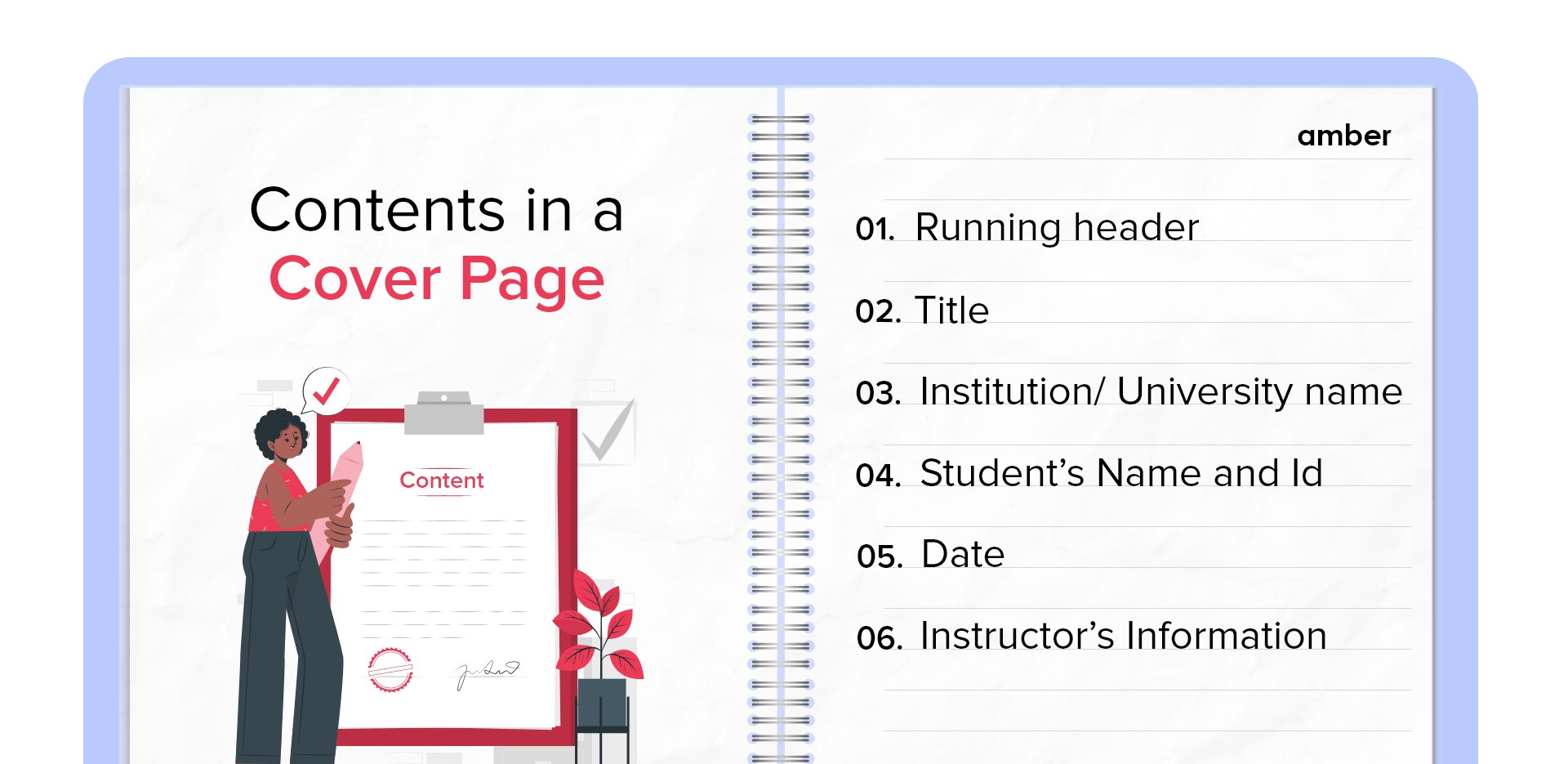
1. Running Header
A running header goes on top of cover pages, separate from the main text. It's often used for APA style. Keep it short, 50 characters max, all uppercase.
Next is the title, explaining your work's content. Write it in the title case, capitalising most words. Avoid abbreviations and aim for 15-20 words. Centre the fully written title on the cover page.
3. Institution/ University Name
Your university or institution name belongs on the cover page, too. Different from the title, it shows readers where you're from and did the research. For reports or presentations, include your workplace or school.
4. Student’s Name and ID
Clearly state the author(s) name(s) and id(s) on the cover page. Include affiliations for multiple authors. For group projects, list all students' names and universities before the title. This ensures proper author credit.
Including the date on your cover page tells readers when you finished the work. Use the exact publication date. This also helps for future reference if someone needs to find work within a certain timeframe.
6. Instructor’s Information
Providing your instructor's details, such as name, designation, and department, shows you completed the work for their specific class. It ensures the assignment reaches the right person and department, avoiding any confusion.
Make your assignment's cover page in peace with amber's comfortable housing!
Book through amber today!
How to Make A Front Page of an Assignment: APA Format
The APA (American Psychological Association) format heavily emphasises the cover page details. To know how to make a cover page for an assignment in an APA format, follow these specific guidelines.
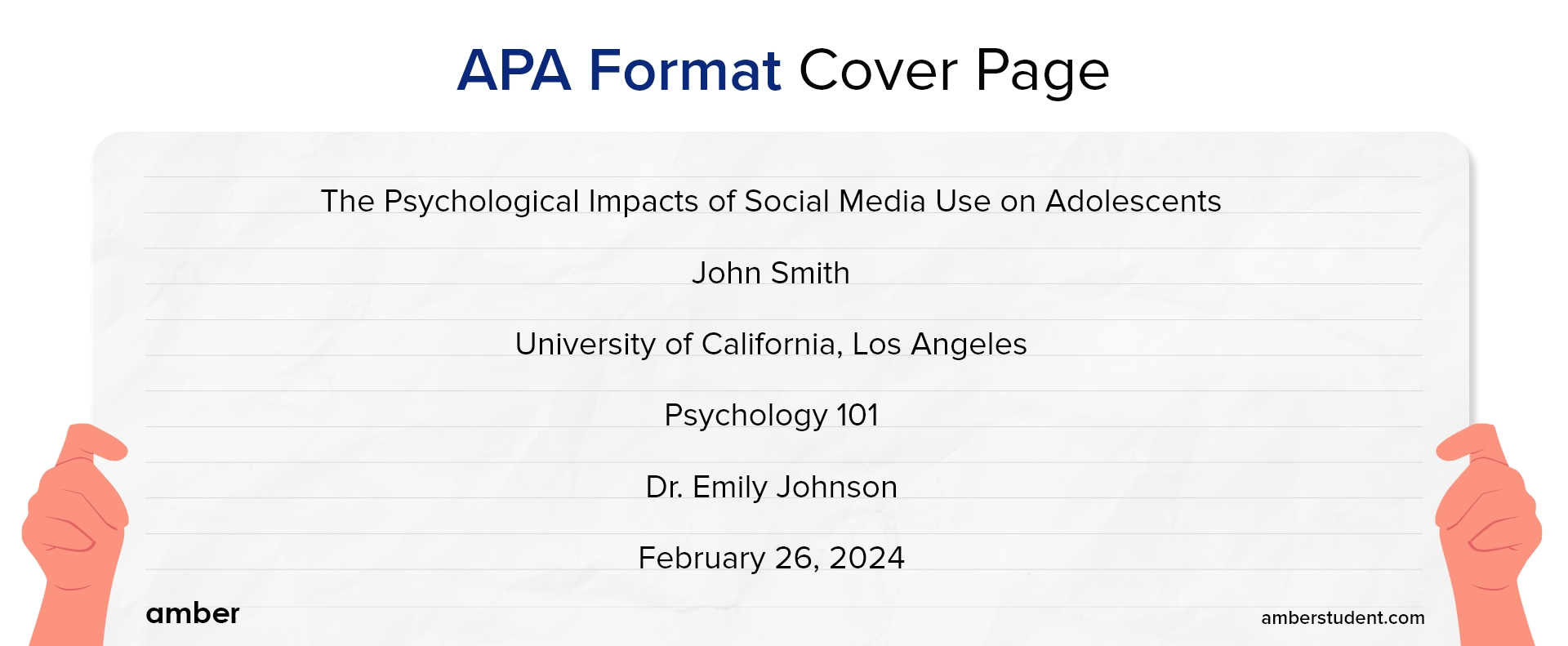
1. Page Number Placement: Start by placing the page number in the upper-right corner, always as 1, aligning it with the one-inch margin. This will be part of your running head, a feature in APA format, but for student papers, it's just the page number.
2. Title Placement: Move down three or four lines (double-spaced) from the top and centre of your paper's title. Make it bold and use proper capitalization rules for titles.
3. Author's Name: After the title, leave an empty line, then write your name. Keep it simple without any special formatting. If there are multiple authors, separate their names with commas and use "and" before the last author's name.
4. Department and School: Below your name, write your department or division, followed by your school's name, separated by a comma.
5. Course Information: Directly below your school's name, include the course name along with its numeric code.
6. Instructor's Name: Under the course information, write your instructor's full name, including any titles like 'Dr.'
7. Date: Finally, on the last line, write the date. Spell out the month for clarity.
How to Create a Cover Page for an Assignment: MLA Format
In MLA (Modern Language Association) style, you usually don't need a cover page; instead, you list essential details at the start of the first page. If you are wondering how to make an assignment front page in MLA style, here are the instructions.
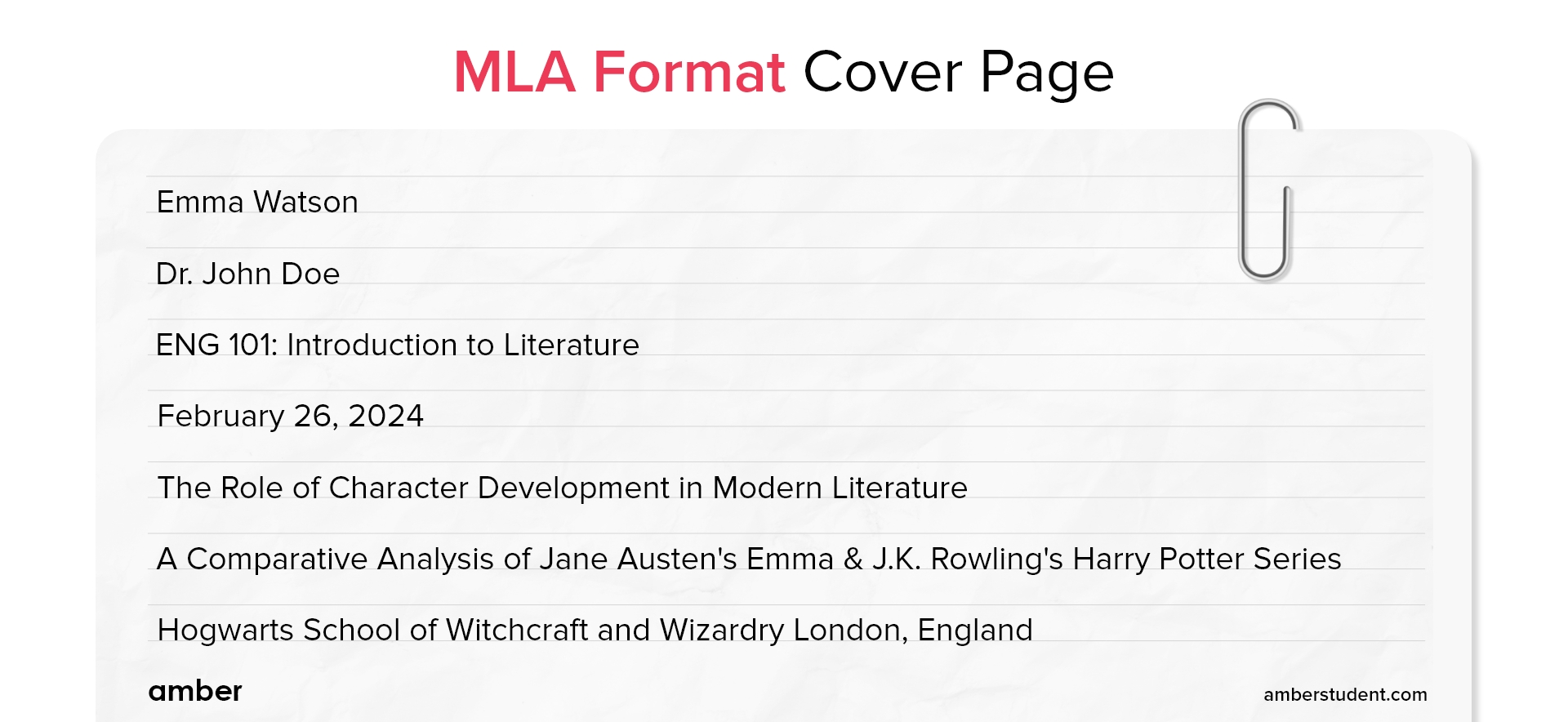
1. Student’s Name: Begin with the first student’s name on the top-left corner of the page, double-spaced.
2. Additional Authors: If there are more authors, list each on a separate line following the first student’s name.
3. Instructor’s Name: Below the last author’s name, including the instructor’s title, like “Professor Willow,” on a new line.
4. Course Details: Write the course name along with its numeric code on the next line.
5. Date : Following the course details, write the date in full, avoiding abbreviations for months. You can use either day-month-year or month-day-year format.
6. Title of the Paper : Centre the title four or five lines below the date, maintaining double spacing. Remember to capitalise the title according to standard rules, avoiding bold or italics.
How to Design Cover Page for Assignment: CMS Format
CMS (Chicago Manual of Style), a citation method for acknowledging sources in academic papers, grants ownership rights to authors, preventing plagiarism and aiding readers in locating sources. However, mastering one style isn't sufficient due to varying rules.
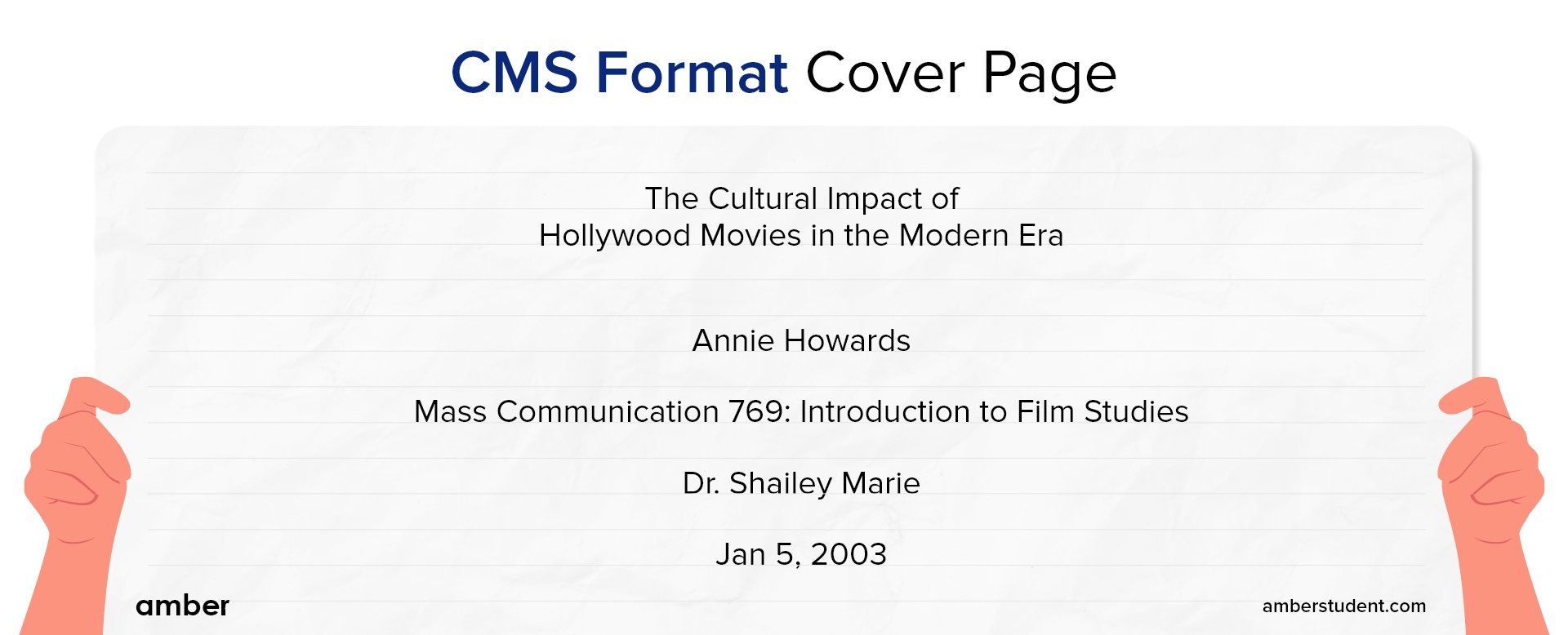
1. Margins: Leave one-inch margins on all sides of your cover page to give it a neat look and provide space for your text.
2. Font: Stick to Times or Times New Roman font in 12 pt size for a professional appearance that's easy to read.
3. Spacing: Double-space the text on your cover page to make it clear and readable.
4. Text Alignment: Align your text to the left to create a clean, organised appearance, avoiding fully justified text.
5. Indentation: Start paragraphs, block quotes, and bibliography entries with a 1/2" indent for a structured layout.
6. Page Numbers: Number your pages in the top right corner, excluding the cover page. Include your last name to avoid confusion if pages get mixed up.
7. Two-Sided Printing: Confirm with your teacher if you can print on both sides of the paper for eco-friendly printing.
8. Title: Centre the title of your paper halfway down the page for prominence and clarity.
9. Name: Centre your name under the title to identify yourself as the author.
10. Teacher's Information: Write your teacher's name, course title, and date at the bottom, centred in three lines.
11. Font Consistency: Maintain consistency by using Times or Times New Roman font in 12 pt size for the cover page. Avoid using bold, underline, or decorative fonts.
12. Page Numbering and Count: Exclude the cover page from page numbering and total page count. It's not necessary to add a page number to the cover page.
Tips and Tricks to How to Make a Good Cover Page for an Assignment?
Now that you have understood how to make a cover page for an assignment, it is also necessary to understand the basic tips and tricks before you start writing one. To make a great cover page, follow the steps outlined in the guide.
1. Correct Information
The main tip for knowing how to design a cover page for an assignment is to ensure that the cover page includes accurate details such as your name, assignment title, course name, date, and any other required information to avoid confusion and errors.
2. Formatting
Use consistent formatting throughout the cover page, including font style, size, and spacing, to present a polished and organised appearance that aligns with academic standards.
3. Relevance
If you’re wondering how to write thea front page of an assignment, then include relevant details that provide context. This would help the reader understand the purpose and scope of your work.
4. Clarity and Conciseness
Keep the content of the cover page clear and concise, using simple language and avoiding unnecessary information to communicate your message effectively.
5. Professional Tone
Maintain a professional tone on the cover page by using formal language and addressing the recipient respectfully, reflecting your commitment to the assignment and your academic integrity.
6. Proofreading
Carefully proofread the cover page for any grammatical errors, typos, or inconsistencies to ensure it reflects your attention to detail and presents a polished final product.
A well-crafted cover page can make your assignment shine like a diamond in the rough. Follow these tips for how to write the front page of an assignment, and you'll impress your professor right off the bat. Don't drop the ball on this crucial first impression; knock their socks off with an A+ cover page material!
Frequently Asked Questions
Do cover pages for an assignment have pictures, what is the difference between a cover letter and a cover page for an assignment, how long should a cover letter for an assignment be, is a 2-page cover letter for an assignment too much, what is the difference between the front page and the cover page.
Your ideal student home & a flight ticket awaits
Follow us on :

Related Posts
.webp)
17 Best Study Apps For Students To Download In 2024

Master's In Canada: Top Colleges, Fees & Eligibility In 2024

16 Best Websites For Cheap Textbooks 2024

Planning to Study Abroad ?

Your ideal student accommodation is a few steps away! Please fill in your details below so we can find you a new home!
We have got your response

amber © 2024. All rights reserved.
4.8/5 on Trustpilot
Rated as "Excellent" • 4800+ Reviews by students
Rated as "Excellent" • 4800+ Reviews by Students

- school Campus Bookshelves
- menu_book Bookshelves
- perm_media Learning Objects
- login Login
- how_to_reg Request Instructor Account
- hub Instructor Commons
Margin Size
- Download Page (PDF)
- Download Full Book (PDF)
- Periodic Table
- Physics Constants
- Scientific Calculator
- Reference & Cite
- Tools expand_more
- Readability
selected template will load here
This action is not available.

2.2: Practice Assignment 2
- Last updated
- Save as PDF
- Page ID 118498
\( \newcommand{\vecs}[1]{\overset { \scriptstyle \rightharpoonup} {\mathbf{#1}} } \)
\( \newcommand{\vecd}[1]{\overset{-\!-\!\rightharpoonup}{\vphantom{a}\smash {#1}}} \)
\( \newcommand{\id}{\mathrm{id}}\) \( \newcommand{\Span}{\mathrm{span}}\)
( \newcommand{\kernel}{\mathrm{null}\,}\) \( \newcommand{\range}{\mathrm{range}\,}\)
\( \newcommand{\RealPart}{\mathrm{Re}}\) \( \newcommand{\ImaginaryPart}{\mathrm{Im}}\)
\( \newcommand{\Argument}{\mathrm{Arg}}\) \( \newcommand{\norm}[1]{\| #1 \|}\)
\( \newcommand{\inner}[2]{\langle #1, #2 \rangle}\)
\( \newcommand{\Span}{\mathrm{span}}\)
\( \newcommand{\id}{\mathrm{id}}\)
\( \newcommand{\kernel}{\mathrm{null}\,}\)
\( \newcommand{\range}{\mathrm{range}\,}\)
\( \newcommand{\RealPart}{\mathrm{Re}}\)
\( \newcommand{\ImaginaryPart}{\mathrm{Im}}\)
\( \newcommand{\Argument}{\mathrm{Arg}}\)
\( \newcommand{\norm}[1]{\| #1 \|}\)
\( \newcommand{\Span}{\mathrm{span}}\) \( \newcommand{\AA}{\unicode[.8,0]{x212B}}\)
\( \newcommand{\vectorA}[1]{\vec{#1}} % arrow\)
\( \newcommand{\vectorAt}[1]{\vec{\text{#1}}} % arrow\)
\( \newcommand{\vectorB}[1]{\overset { \scriptstyle \rightharpoonup} {\mathbf{#1}} } \)
\( \newcommand{\vectorC}[1]{\textbf{#1}} \)
\( \newcommand{\vectorD}[1]{\overrightarrow{#1}} \)
\( \newcommand{\vectorDt}[1]{\overrightarrow{\text{#1}}} \)
\( \newcommand{\vectE}[1]{\overset{-\!-\!\rightharpoonup}{\vphantom{a}\smash{\mathbf {#1}}}} \)
Assignment Introduction
This essay is more challenging than the argument summary & response you were assigned for essay 1 (the assignments continue to build in difficulty throughout the term). This time you must write a specific type of argument essay: an argument of definition. While it will take some hard work and deep thinking, I know you can do it!
Please ask questions and send me drafts of thesis statements or essay ideas when you want some feedback!
With arguments of definition, student writers practice the skills required to think critically about people, places, and things in the world and the definitions or categories we unthinkingly ascribe to them.
Commonly accepted definitions are often inadequate and based on uncritical acceptance of formal dictionary definitions or operational definitions.
There are many reasons why it may be critically important to change or clarify the meaning, explanation, or usage of a term:
- Society can outgrow a definition as technology and culture change the word in which we live (for instance we've had to adapt new meanings for "Google" and "Zoom," and even the way we are using the words "quarantine," "global pandemic," and "social-distancing" have changed very recently and require new modern definitions).
- Definitions can be harmful to people (as in the case of stereotypes or racial slurs that hurt people and require modifications to be more politically and socially correct--the controversial term "Hispanic," the changing terms "American Indian" and "queer," and the creation of the gender-neutral term "LatinX" and pronouns "ze" and "zir" come to mind)
- Without change, definitions can outlive their use (the idea "primetime" has become obsolete in the age of internet broadcasting on demand--and the meaning of "racist" has had to grow and evolve to keep up with the changes of the times)
- Definitions can mislead (as when "intellectual property " is given the same rights as real property; when corporations are given the status of "individuals" without being beholden to the assumption that individuals have ethical obligations.)
The Writing Process for This Assignment
1. Conduct some research in order to explore topics that hold your interest:
- Begin by questioning the definition of a few significant terms that appear frequently in the modern media you consume
- Complete some internet research on where, when, how, and why the words are regularly used. What do they usually mean and what else do they imply to readers? In what ways can you more clearly explain the terms and offer some additional meaning?
- Why are some writers using the word "rioters" and some using the word "protesters"?
- Why does the word "terrorist" or "terrorism" appear in some articles and not in the articles that take an opposing view of the same situations?
- Is it even possible for a philosophy such as "anti-fascism" to be categorized as a "terrorist organization," as it has been called by Trump recently?
- See the previous page: "Learn to Write an Argument of Definition" for additional ideas
- Search The Perspective website to see two opposing perspectives of current events and ongoing local and word debates
- questions that can be answered by looking at a dictionary or other reference make poor topics. Your point needs to be modern, significant, and arguable. Your ideas and persuasive essay should be important for society to read because there will be some people who disagree with your ideas and require a careful explanation.
- papers about the definition of love or friendship tend to be weak because people are used to thinking of their characteristics a matter of personal rather than public preference. Discover a topic more significant to what's going on in the world and join a critical, modern conversation.
- For example, while "abortion is murder" is a definition argument, it's not a good topic for a college essay. You can't address the definition of life and the definition of murder in such a short essay and you are likely to run into problems with logical fallacies and "bad arguments" with such a topic." Stay away from these clichéd topics. Stick with arguments that people are likely to disagree about or have never thought of but still can be persuaded by.
- For example: "sweatshop labor is bad" is a poor topic, but "sweatshop labor is slavery" is a better topic choice. Whether you define sweatshop labor as slavery or not will certainly matter. People already feel that is bad, so if you can convince people that sweatshop labor is slavery, you've won your definition argument and people will hopefully disapprove of sweatshop labor as they disapprove of slavery.
2. Conduct additional research to build your ideas and make a final topic selection:
- Explore accepted dictionary definitions
- Explore people's assumptions about the definitions—ask your friends and family members their definition. Are the definitions the same as yours or each others'?
- Look in books about the topic to see how people are using the word or category
- What does the accepted definition exclude?
- Example: Cheerleading isn't often thought of as a sport,but similar activities such as rhythm gymnastics have Olympic events, so cheerleading should be considered a sport.
- Will you be able to find more examples that support your ideas?
- Can you find some use examples that show what you consider to be lacking in the current definition and usage and more examples that demonstrate a better usage or meaning?
- If you are making a comparison of two terms, can you explain and provide examples for both terms?
3. Create an argument with a new definition, category, or explanation of the word or term you chose:
- Identify the ways in which the accepted definition or category ascribed to a term is lacking or doesn't hold up to critical inquiry.
- Identify what's at stake. Why should people care about the definition at all? What are the consequences of people's misunderstanding?
- Identify modifications to the definition that will help the readers define or categorize the term in a way that is more useful.
- Main claim (pattern for operational argument): Although [topic] is usually considered to be a [category] , it's better categorized as a[different category] .
- Main claim (pattern for formal argument): Though [topic] is usually defined as [standard, uncritical definition] , a more accurate definition is [your new definition based on inquiry into the "true nature" of the topic]
4. Outline your ideas and examples
- First – In your introduction, summarize the details of the problem: Why isn't the basic definition good enough at explaining the term? What's missing? End your introduction with a thesis that presents your claim for a new definition, explanation, or category.
- Second – Provide detailed explanations of the idea you want to add as part of the "new definition" of the term. Include supporting points.
- Third – Present detailed support for all your points with a focus about how your claims works in the world. Include real examples and evidence to show your claim.
- Fourth- (Optional) Consider a negative example. Can you include an example of what this term is not in order to help your readers understand what it is? Are there examples in the media of it being used in a way you disagree with?
- Fifth – Finally, in your conclusion, summarize the main points of your claim and relate your issue to the bigger picture. Make it clear to your audience that a new-found understanding of the issue leads to a better understanding and support for your claim. Add the"so what?" to help connect your topic ideas to society and to your readers' real-world.
5. Construct your first essay draft:
- This can be messy and have ideas. Don't worry about it. Relax and just get something down on paper so you can begin to fix it up.
- Consider your audience of professors and other college students
- Include strategies to build your authority and credibility
- a personal anecdote (very short story) about how you or others connect with the term in the real world
- an expert quotation relevant to your ideas (but NOT a simple dictionary definition--assume your readers already know what basic words mean and that you are adding a NEW layer of explanation)
- relevant facts, statistics, or logical information
- opposing views: Is there a counterargument or counter example that can be addressed as part of you convincing your audience?
- cultural implications or the impact of your idea on the greater society
6. Edit and revise your work carefully to fix errors and check for clear understanding:
- Be sure that all your ideas support your main point, you have explained your ideas clearly, and you have provided support and/or examples for each one.
- Check that you've began in an interesting way, connected your ideas to a meaningful concept that matters to a particular community or society as a whole, and ended with powerful wording.
- Have at least one other person read your work. Trade papers with a classmate, see a tutor, or have a friend read your essay. Have that person point out places that don't make sense, need more explanation, or aren't clear.
- Edit your sentences and words, and proofread for accuracy and correctness. Make sure you have complete sentences and correct punctuation and capitalization.
- Format your essay according to MLA guidelines.
- Read it again and again. Make sure it's your very best work before you turn it in!
Additional Tips for Completing this Argument Essay:
- Make absolutely certain to avoid plagiarism of any type. Main ideas and arguments need to be your own. Find a unique way to join the conversation by contributing some piece of your opinion, knowledge, and experience to the topic you choose. The words in your essay need to be completely your own (other than the few word or sentences you choose to quote).
- There's no need to feel shy about expressing your own opinion in an argument essay. While you must have researched, real-world examples to support your ideas, you may also build your authority and credibility by explaining a personal connection with the topic or a related narrative based on your life experience (if you have one). In this case, you may have some parts of your essay written in first person and use "I" or "my."
- Although an MLA Works Cited Page is not required for this essay (it's optional--if you're already comfortable with the strategies), it is necessary for you to include the TITLE and author/speaker of ANY source you reference. Introduce and carefully integrate any quotations, summary, or paraphrase from a source into your writing. See the page: "Learn to Integrate Quotations into Your Writing (quote sandwich)" for a review of these writing strategies.
The Grading of a Practice Assignment
What goals/skills should I focus on in order to do my best? Your goal is to show your current ability in the following areas that are considered entry-level skills for basic essay writing.
- Understand the reading assignment and explain the author’s ideas briefly and clearly as you reference the text in your essay.
- Follow the prompt directions. Keep all your ideas tied to the general topic introduced in the reading. *If you don’t understand the prompt question in class, ask questions!
- Follow the basic American-essay guidelines of organizing sentences into logical paragraphs, and paragraphs into an essay. Try to write a clear intro, body, and conclusion (beginning, middle, and end structure).
- Reveal your skill in critical thinking and your ability to clearly express an idea of your own. Add something of your own to the conversation topic.
- Include a clear thesis statement that builds on or challenges the ideas of the text. Then offer effective explanation and support for your ideas.
- Edit and revise with enough accuracy that all ideas are clear and easy for readers to follow. Any errors should not distract from your main point or make your sentences unreadable.
If any part of the above criteria feels new to you, don’t worry. Your instructor will assess your skills, look for the positive in your work, and then help you by providing the best guidance and support to move your education forward and get your writing skills to the next level!
If you get a score of "Not Yet," you will need to edit and revise:
Revising your paper is not skimming a paper while watching TV. Revising is focusing on many elements in your draft. While you should edit for sentence-level and grammatical errors while you revise, editing is only a small part of what needs to be accomplished in a revision. You should revise your paper several times before turning it in for a deadline. To revise for a final submission, you may need to completely over-haul your essay to prove that you deserve a better score than you got on a previous draft. Show that you have really become a better writer. If all you do is fix a few grammatical errors, it will likely not result in a significant grade increase, and if your essay still contains other major concerns, you might not receive an improved grade. Learning how to improve your writing through a thorough revision process will not only increase your essay score, but will make you a better writer, which will benefit you in upcoming writing assignments and far beyond the end of this course. Here is a partial list of things to consider while revising an essay.
Refer to the grading rubric. How do you think your essay measures up? What could be changed to improve your rubric score? If you already have feedback from the professor, read it carefully and address ALL of the concerns. If you need to do more studying to address the concerns please try the Purdue OWL website, your recommended text books, and your class notes.
Once you write a complete draft of your essay, you revise it--adding material, deleting material, and making corrections. You then continue the revision process by revising your paper again...and then again. Have several other people (trusted peers AND tutors from DVC) read and discuss your essay with you. They cannot make changes for you or tell you what to write, but they can discuss elements of your paper that are not clear, disconnected, or need more work. Fresh eyes and an outsider’s perspective will do wonders for your writing!
You will need to submit it to Canvas before the revision deadline which will be approximately one-week after you receive your score. Be careful to submit to the correct assignment or it will not get scored! You can still earn a "Pass" for the essay by showing that you have developed skills with the required writing criteria.
Most importantly, don’t lose confidence in your ability to work hard and continue learning. The more essays you write (and re-write/revise) the more your skills will be developed and refined. This is a learning opportunity for you and a chance for you to complete your work at an elevated level!
If you get a score of "Pass," you will not need to edit and revise:
This means your writing demonstrated the skills for basic essay writing at a satisfactory level for the assignment. Unless otherwise noted in the assignment directions, this will be determined by the ENGL-122 writing rubric. Students whose writing matches the "meets expectations" or "exceeds expectations" criteria will receive a grade of 100%. You you will be asked to reflect on what you did well for this assignment and what your goals are for improvement. You will need to then apply your new knowledge and goals to your future writing. It means you are ready to move on to the next writing task in this course. Please continue to develop additional writing skills and advance your writing with deeper ideas. The writing assignments in this class will continue to get more advanced and more challenging!

An APA Guide for Students and Faculty

APA Assignment: General Page Format Requirements
Academic writing at Confederation College must always be formatted according to APA guidelines.
How to Format an APA Document
Use one of the following APA fonts: 12 pt. font, Times New Roman or 11 pt. font, Calibri (Body).
How to Change the Font Size.
To change the font, click on the “Home” tab in Microsoft Word, and choose the style and font size in the dropdown menus (A and B), as pictured in Figure 1.

Page Margins
Your document must have 1” (one inch) page margins on the top, sides, and bottom of the document.
How to Check the Page Margin Size.
Click the “Layout” tab (A) in Microsoft Word, and click the “Margins” drop-down arrow (B). Click on the “Normal (2.54 cm)” margin selection (C), as pictured in Figure 2.

Paragraph Alignment
All assignment paragraphs (for essays, formal reports, or informal reports) must be ragged, left aligned. You should never manually adjust the word spacing or hyphenate any words to make the paragraph flush with both margins.
How to Make an Assignment Left Aligned.
Under the “Home” tab, click the left align button (A), as shown in Figure 3.

APA Assignments: How to Format Mandatory Components
There are mandatory components that, unless otherwise indicated by your Confederation College professor, must accompany all assignments that you submit. Every assignment must have an APA title page, and if you have taken any information from a secondary source, you must also include an APA References page. See the References section of this guide for the References page formatting instructions.
APA Title Page
Your APA title page is the first page of your assignment, and it must abide by APA guidelines. Follow the long instructions in Figure 6 or use the short instructions in Figure 5 to create an APA title page
If you have followed the directions to create an APA title page, the layout of your APA title page should look exactly like the title page in Figure 4. If it does not look identical, you have missed a step, and therefore, your APA title page is formatted incorrectly.

How to Create an APA Title Page

APA References Page
The References page contains a list of all of the sources that you paraphrased, quoted, or summarized in your paper. See the “Avoiding Plagiarism” section for more information about what sources you need to cite and reference. See the “References” section of this guide for more information about how to format the References page and how to create each reference entry.
Templates for college and university assignments
Include customizable templates in your college toolbox. stay focused on your studies and leave the assignment structuring to tried and true layout templates for all kinds of papers, reports, and more..

Keep your college toolbox stocked with easy-to-use templates
Work smarter with higher-ed helpers from our college tools collection. Presentations are on point from start to finish when you start your project using a designer-created template; you'll be sure to catch and keep your professor's attention. Staying on track semester after semester takes work, but that work gets a little easier when you take control of your scheduling, list making, and planning by using trackers and planners that bring you joy. Learning good habits in college will serve you well into your professional life after graduation, so don't reinvent the wheel—use what is known to work!
Word & Excel Templates
Printable Word and Excel Templates
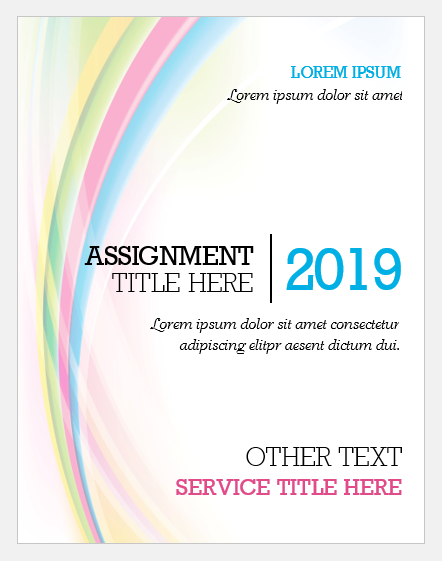
Assignment Cover Pages
Assignment cover page is the first page of an assignment. When you hold an assignment, the first page that you will see is the cover page. It is also called the title page. An assignment cover page includes the name of the institution, the title of the assignment, the name of the student and student’s ID. The assignment cover page is helpful in identifying what the assignment is about and which student submitted it.
Many students submit assignments to instructors, and instructors are usually teaching more than one subject. Therefore, without an assignment cover page, it would be difficult for the instructor to manage and sort out different assignments.
When there is an assignment cover page, instructors can easily sort out the assignments and grade them. Even the students submitting multiple assignments on the same day could end up submitting the wrong assignment if the assignments didn’t have a cover page.
Another important reason for having assignment cover pages is that this is part of training students to submit work professionally. An assignment cover page shows professionalism in submitting work. When students are trained for professional work, they are better equipped at succeeding in their jobs. Thus, professors and instructors usually ask students to create cover pages for their assignments so that the students develop this habit early in their academic life.
The assignment cover page usually includes the name of the institution, title of the assignment, name of the student, student id, date of submission. In some cases, the title page may also mention the instructor name. Usually, the title page is not page numbered.
Some courses might also require the students to format the assignment cover pages using popular referencing styles. For example, there is a particular format to make an assignment cover page using APA or MLA referencing styles. In some cases, professors may also issue detailed instructions on how to format an assignment cover page. These instructions may include font style, font size, text color, page borders, and the information that must be stated on the cover page along with a particular order.
Cover pages are required in several situations:
- When submitting a project report
- When submitting a research proposal
- When submitting a dissertation
- When making a report that is longer than 2-3 pages
- When the assignment instructions require an assignment cover page
- When the professor is handling more than one subject and assignments may be erroneously sorted
Assignment cover pages are very useful and can be created in MS Word or Adobe. MS Word software allows pictures and text to be used on the cover page. Students may also use headers and footers, page borders and other features in MS Word to create a nice cover page. You can even use the popular heading styles given in MS Word.
If you do not have the time or energy to create a cover page, you may use cover pages available on our website. We offer editable cover page templates that you can easily download and customize. Browse through our specially designed assignment cover pages and save your time and effort.
for Education
- Google Classroom
- Google Workspace Admin
- Google Cloud

Easily distribute, analyze, and grade student work with Assignments for your LMS
Assignments is an application for your learning management system (LMS). It helps educators save time grading and guides students to turn in their best work with originality reports — all through the collaborative power of Google Workspace for Education.
- Get started
- Explore originality reports
Bring your favorite tools together within your LMS
Make Google Docs and Google Drive compatible with your LMS
Simplify assignment management with user-friendly Google Workspace productivity tools
Built with the latest Learning Tools Interoperability (LTI) standards for robust security and easy installation in your LMS
Save time distributing and grading classwork
Distribute personalized copies of Google Drive templates and worksheets to students
Grade consistently and transparently with rubrics integrated into student work
Add rich feedback faster using the customizable comment bank
Examine student work to ensure authenticity
Compare student work against hundreds of billions of web pages and over 40 million books with originality reports
Make student-to-student comparisons on your domain-owned repository of past submissions when you sign up for the Teaching and Learning Upgrade or Google Workspace for Education Plus
Allow students to scan their own work for recommended citations up to three times
Trust in high security standards
Protect student privacy — data is owned and managed solely by you and your students
Provide an ad-free experience for all your users
Compatible with LTI version 1.1 or higher and meets rigorous compliance standards
Product demos
Experience google workspace for education in action. explore premium features in detail via step-by-step demos to get a feel for how they work in the classroom..
“Assignments enable faculty to save time on the mundane parts of grading and...spend more time on providing more personalized and relevant feedback to students.” Benjamin Hommerding , Technology Innovationist, St. Norbert College
Classroom users get the best of Assignments built-in
Find all of the same features of Assignments in your existing Classroom environment
- Learn more about Classroom
Explore resources to get up and running
Discover helpful resources to get up to speed on using Assignments and find answers to commonly asked questions.
- Visit Help Center
Get a quick overview of Assignments to help Educators learn how they can use it in their classrooms.
- Download overview
Get started guide
Start using Assignments in your courses with this step-by-step guide for instructors.
- Download guide
Teacher Center Assignments resources
Find educator tools and resources to get started with Assignments.
- Visit Teacher Center
How to use Assignments within your LMS
Watch this brief video on how Educators can use Assignments.
- Watch video
Turn on Assignments in your LMS
Contact your institution’s administrator to turn on Assignments within your LMS.
- Admin setup
Explore a suite of tools for your classroom with Google Workspace for Education
You're now viewing content for a different region..
For content more relevant to your region, we suggest:
Sign up here for updates, insights, resources, and more.
6.894 : Interactive Data Visualization
Assignment 2: exploratory data analysis.
In this assignment, you will identify a dataset of interest and perform an exploratory analysis to better understand the shape & structure of the data, investigate initial questions, and develop preliminary insights & hypotheses. Your final submission will take the form of a report consisting of captioned visualizations that convey key insights gained during your analysis.
Step 1: Data Selection
First, you will pick a topic area of interest to you and find a dataset that can provide insights into that topic. To streamline the assignment, we've pre-selected a number of datasets for you to choose from.
However, if you would like to investigate a different topic and dataset, you are free to do so. If working with a self-selected dataset, please check with the course staff to ensure it is appropriate for the course. Be advised that data collection and preparation (also known as data wrangling ) can be a very tedious and time-consuming process. Be sure you have sufficient time to conduct exploratory analysis, after preparing the data.
After selecting a topic and dataset – but prior to analysis – you should write down an initial set of at least three questions you'd like to investigate.
Part 2: Exploratory Visual Analysis
Next, you will perform an exploratory analysis of your dataset using a visualization tool such as Tableau. You should consider two different phases of exploration.
In the first phase, you should seek to gain an overview of the shape & stucture of your dataset. What variables does the dataset contain? How are they distributed? Are there any notable data quality issues? Are there any surprising relationships among the variables? Be sure to also perform "sanity checks" for patterns you expect to see!
In the second phase, you should investigate your initial questions, as well as any new questions that arise during your exploration. For each question, start by creating a visualization that might provide a useful answer. Then refine the visualization (by adding additional variables, changing sorting or axis scales, filtering or subsetting data, etc. ) to develop better perspectives, explore unexpected observations, or sanity check your assumptions. You should repeat this process for each of your questions, but feel free to revise your questions or branch off to explore new questions if the data warrants.
- Final Deliverable
Your final submission should take the form of a Google Docs report – similar to a slide show or comic book – that consists of 10 or more captioned visualizations detailing your most important insights. Your "insights" can include important surprises or issues (such as data quality problems affecting your analysis) as well as responses to your analysis questions. To help you gauge the scope of this assignment, see this example report analyzing data about motion pictures . We've annotated and graded this example to help you calibrate for the breadth and depth of exploration we're looking for.
Each visualization image should be a screenshot exported from a visualization tool, accompanied with a title and descriptive caption (1-4 sentences long) describing the insight(s) learned from that view. Provide sufficient detail for each caption such that anyone could read through your report and understand what you've learned. You are free, but not required, to annotate your images to draw attention to specific features of the data. You may perform highlighting within the visualization tool itself, or draw annotations on the exported image. To easily export images from Tableau, use the Worksheet > Export > Image... menu item.
The end of your report should include a brief summary of main lessons learned.
Recommended Data Sources
To get up and running quickly with this assignment, we recommend exploring one of the following provided datasets:
World Bank Indicators, 1960–2017 . The World Bank has tracked global human developed by indicators such as climate change, economy, education, environment, gender equality, health, and science and technology since 1960. The linked repository contains indicators that have been formatted to facilitate use with Tableau and other data visualization tools. However, you're also welcome to browse and use the original data by indicator or by country . Click on an indicator category or country to download the CSV file.
Chicago Crimes, 2001–present (click Export to download a CSV file). This dataset reflects reported incidents of crime (with the exception of murders where data exists for each victim) that occurred in the City of Chicago from 2001 to present, minus the most recent seven days. Data is extracted from the Chicago Police Department's CLEAR (Citizen Law Enforcement Analysis and Reporting) system.
Daily Weather in the U.S., 2017 . This dataset contains daily U.S. weather measurements in 2017, provided by the NOAA Daily Global Historical Climatology Network . This data has been transformed: some weather stations with only sparse measurements have been filtered out. See the accompanying weather.txt for descriptions of each column .
Social mobility in the U.S. . Raj Chetty's group at Harvard studies the factors that contribute to (or hinder) upward mobility in the United States (i.e., will our children earn more than we will). Their work has been extensively featured in The New York Times. This page lists data from all of their papers, broken down by geographic level or by topic. We recommend downloading data in the CSV/Excel format, and encourage you to consider joining multiple datasets from the same paper (under the same heading on the page) for a sufficiently rich exploratory process.
The Yelp Open Dataset provides information about businesses, user reviews, and more from Yelp's database. The data is split into separate files ( business , checkin , photos , review , tip , and user ), and is available in either JSON or SQL format. You might use this to investigate the distributions of scores on Yelp, look at how many reviews users typically leave, or look for regional trends about restaurants. Note that this is a large, structured dataset and you don't need to look at all of the data to answer interesting questions. In order to download the data you will need to enter your email and agree to Yelp's Dataset License .
Additional Data Sources
If you want to investigate datasets other than those recommended above, here are some possible sources to consider. You are also free to use data from a source different from those included here. If you have any questions on whether your dataset is appropriate, please ask the course staff ASAP!
- data.boston.gov - City of Boston Open Data
- MassData - State of Masachussets Open Data
- data.gov - U.S. Government Open Datasets
- U.S. Census Bureau - Census Datasets
- IPUMS.org - Integrated Census & Survey Data from around the World
- Federal Elections Commission - Campaign Finance & Expenditures
- Federal Aviation Administration - FAA Data & Research
- fivethirtyeight.com - Data and Code behind the Stories and Interactives
- Buzzfeed News
- Socrata Open Data
- 17 places to find datasets for data science projects
Visualization Tools
You are free to use one or more visualization tools in this assignment. However, in the interest of time and for a friendlier learning curve, we strongly encourage you to use Tableau . Tableau provides a graphical interface focused on the task of visual data exploration. You will (with rare exceptions) be able to complete an initial data exploration more quickly and comprehensively than with a programming-based tool.
- Tableau - Desktop visual analysis software . Available for both Windows and MacOS; register for a free student license.
- Data Transforms in Vega-Lite . A tutorial on the various built-in data transformation operators available in Vega-Lite.
- Data Voyager , a research prototype from the UW Interactive Data Lab, combines a Tableau-style interface with visualization recommendations. Use at your own risk!
- R , using the ggplot2 library or with R's built-in plotting functions.
- Jupyter Notebooks (Python) , using libraries such as Altair or Matplotlib .
Data Wrangling Tools
The data you choose may require reformatting, transformation or cleaning prior to visualization. Here are tools you can use for data preparation. We recommend first trying to import and process your data in the same tool you intend to use for visualization. If that fails, pick the most appropriate option among the tools below. Contact the course staff if you are unsure what might be the best option for your data!
Graphical Tools
- Tableau Prep - Tableau provides basic facilities for data import, transformation & blending. Tableau prep is a more sophisticated data preparation tool
- Trifacta Wrangler - Interactive tool for data transformation & visual profiling.
- OpenRefine - A free, open source tool for working with messy data.
Programming Tools
- JavaScript data utilities and/or the Datalib JS library .
- Pandas - Data table and manipulation utilites for Python.
- dplyr - A library for data manipulation in R.
- Or, the programming language and tools of your choice...
The assignment score is out of a maximum of 10 points. Submissions that squarely meet the requirements will receive a score of 8. We will determine scores by judging the breadth and depth of your analysis, whether visualizations meet the expressivenes and effectiveness principles, and how well-written and synthesized your insights are.
We will use the following rubric to grade your assignment. Note, rubric cells may not map exactly to specific point scores.
Submission Details
This is an individual assignment. You may not work in groups.
Your completed exploratory analysis report is due by noon on Wednesday 2/19 . Submit a link to your Google Doc report using this submission form . Please double check your link to ensure it is viewable by others (e.g., try it in an incognito window).
Resubmissions. Resubmissions will be regraded by teaching staff, and you may earn back up to 50% of the points lost in the original submission. To resubmit this assignment, please use this form and follow the same submission process described above. Include a short 1 paragraph description summarizing the changes from the initial submission. Resubmissions without this summary will not be regraded. Resubmissions will be due by 11:59pm on Saturday, 3/14. Slack days may not be applied to extend the resubmission deadline. The teaching staff will only begin to regrade assignments once the Final Project phase begins, so please be patient.
- Due: 12pm, Wed 2/19
- Recommended Datasets
- Example Report
- Visualization & Data Wrangling Tools
- Submission form
28+ Best Free Assignment Cover Page Formats for MS Word
What is an assignment cover page, key elements for a comprehensive front page.
- Institution Details: Begin by prominently featuring the name of your school, college, or institute. This establishes credibility and provides context for your assignment.
- Personal Information: Include your own name to indicate authorship and ownership of the assignment. This adds a personal touch and facilitates easy identification.
- Assignment Title: Clearly state the title of your assignment, conveying its purpose and focus. A concise and informative title sets the tone for your work.
- Course Information: Specify the relevant course title or code to indicate the academic context in which your assignment was completed. This assists in proper categorization and organization.
- Instructor’s Name: Acknowledge the teacher or professor who will be evaluating your assignment by including their name. This demonstrates respect and professionalism.
- Due Date: Clearly indicate the deadline or due date for the assignment submission. This ensures timely assessment and helps you stay organized.
What are the basic tips?
- Font style : It is always in the best interest to use bold, simple, and clear text instead of using fancy text fonts and styles. This helps the reader understand things in a better way. Moreover, the usage of pictures behind texts must be avoided as it creates poor visibility for the reader when reading the text printed on it.
- Presentation: Presentation plays an important role in expressing what you need to convey to someone and how you need to communicate it. Presenting the title page in the most effective manner is essential as this leaves an impression on the teacher reading the assignment. It also acts as a decisive tool for the teacher whether or not he/ she interestingly goes through the whole document.
- Spell Check: Before handing over the assignment, one should take a brief review of all the spelling and also look for any grammatical errors.
- Avoid plagiarism: A student must always be honest in what he writes. He should avoid copying material or texts from anywhere.
- Personal detail: One should never forget to mention his/her name. The font size used for writing the name must be bigger so that it makes the name visible to the teacher.
Advantages of an Impressive Assignment Cover Page
- Showcasing Professionalism: By meticulously designing your cover page, you demonstrate a strong commitment to professionalism. This attention to detail reflects positively on your work ethic and sets you apart as a dedicated student.
- Creating a Positive Impression: A well-crafted front page sets the tone for your assignment, capturing the attention of your teacher or professor. It establishes a positive first impression, arousing their interest and encouraging them to delve further into your work.
- Enhancing Visual Appeal: A visually appealing cover page enhances the overall presentation of your assignment. With carefully chosen fonts, colors, and layouts, you create an engaging and aesthetically pleasing introduction that captivates the reader’s attention.
- Communicating Pertinent Information: It provides a concise summary of essential details, such as the assignment title, your name, and the due date. This ensures clarity and facilitates seamless identification and organization of your work.
- Reflecting a Professional Attitude: By dedicating time and effort to creating an impressive cover page, you exemplify a professional attitude towards your academic pursuits. This level of dedication and care leaves a lasting impression on your teacher or professor.
Download Free Cover Page Templates
#1 – best format.

#2 – Assignment Cover Page for Case Study
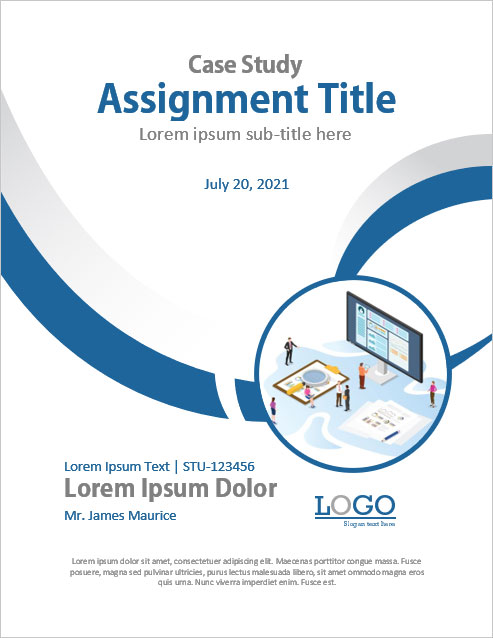
#3 – Best Design for Critical Review
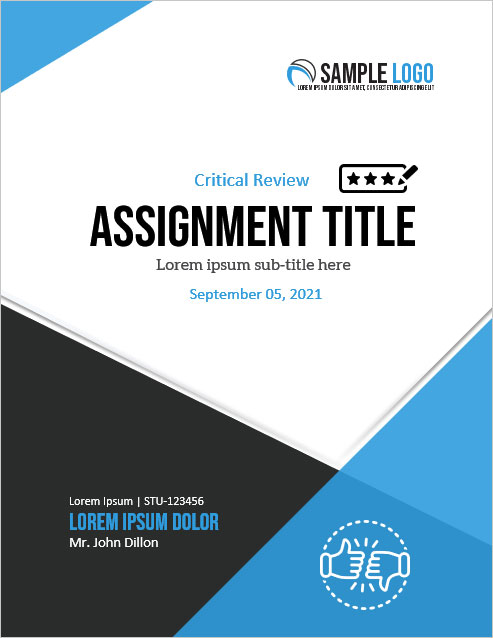
#4 – For Any Kind of Educational Assignment
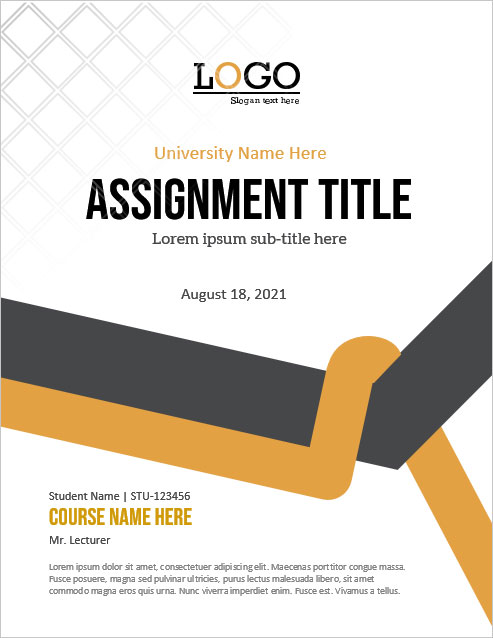
Video Tutorial
#5 – essay assignment.
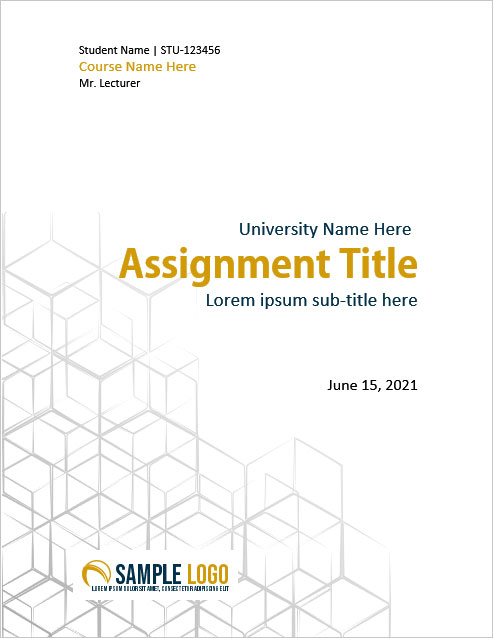
#6 – Syllabus Assignment
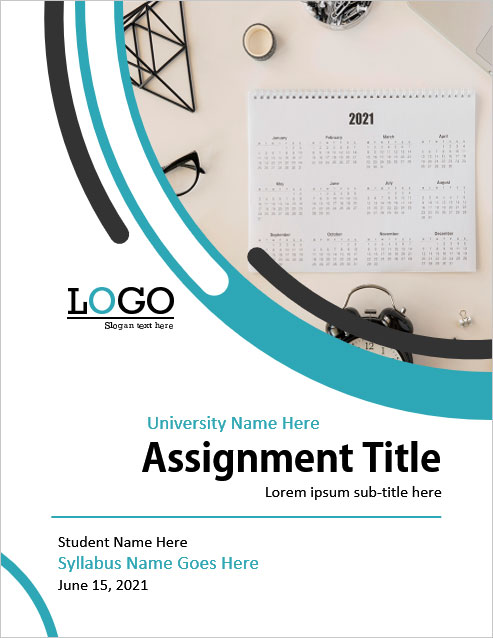
#7 – Cover Page For University Assignments
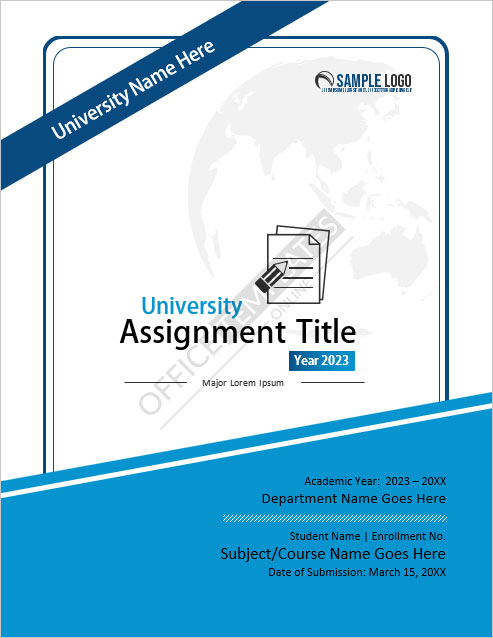
#14 – Cover Page for Business Assignment
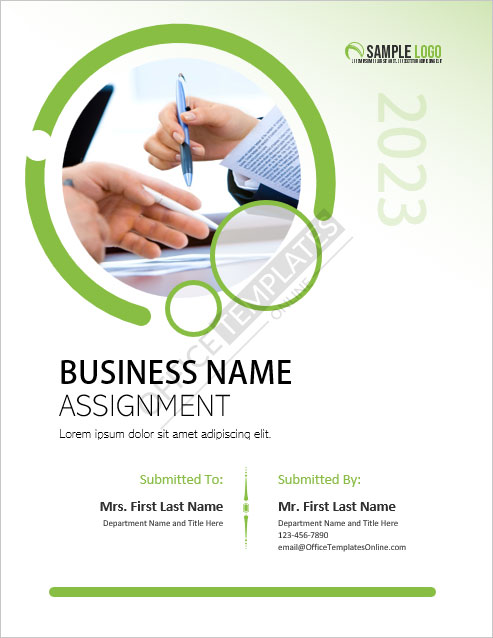
#16 – Academic
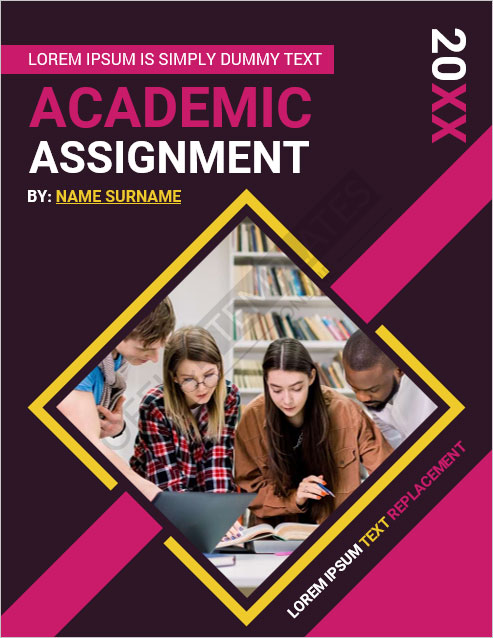
#17 – Generic Cover Page for any Assignment
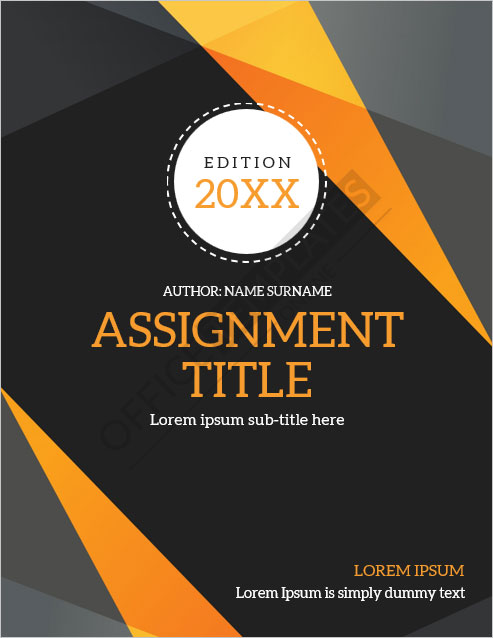
#18 – Biology Assignment
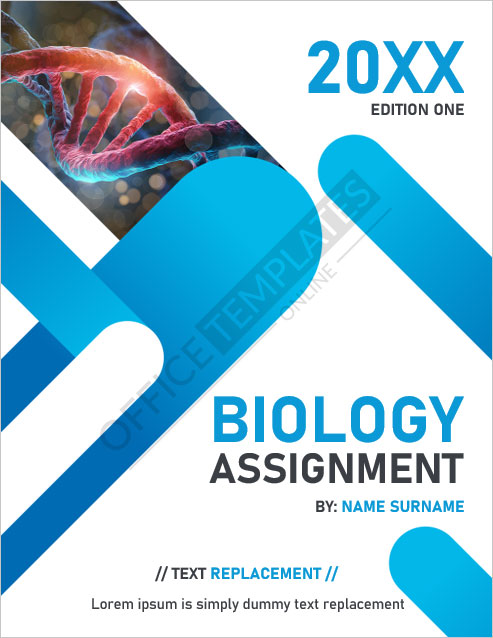
#19 – For Chemistry Projects

#20 – Cover Page for Computer Projects
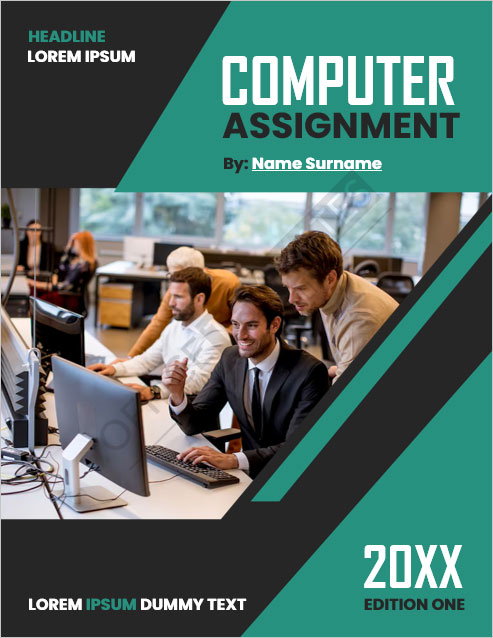
#21 – For Engineering-Related Assignments
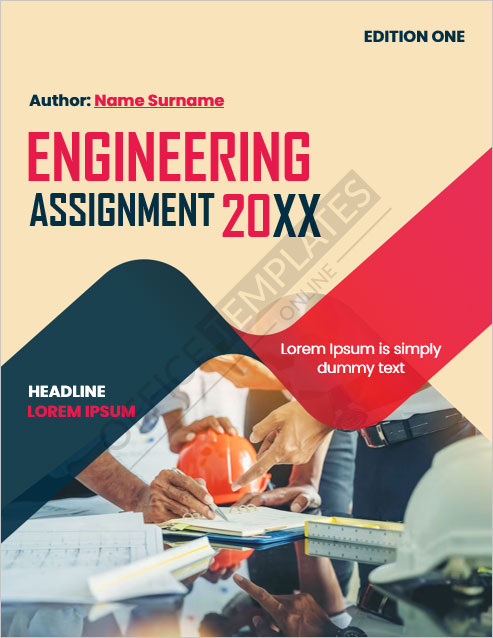
#22 – For English Assignment
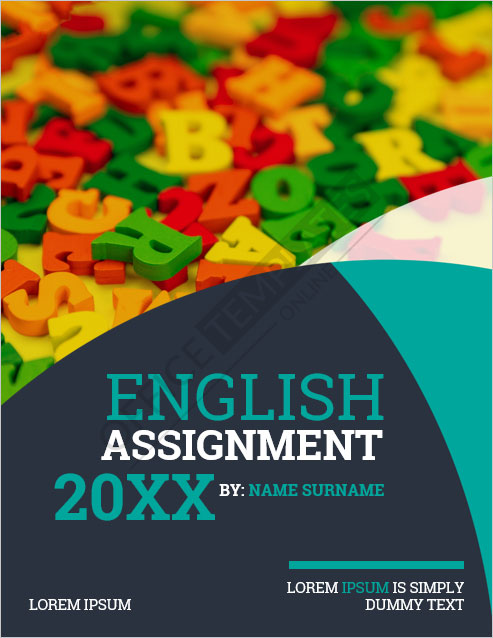
#23 – For Geography Projects
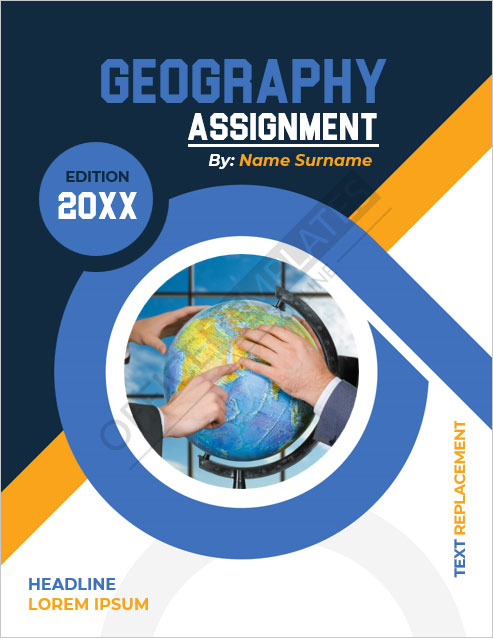
#24 – Mathematics
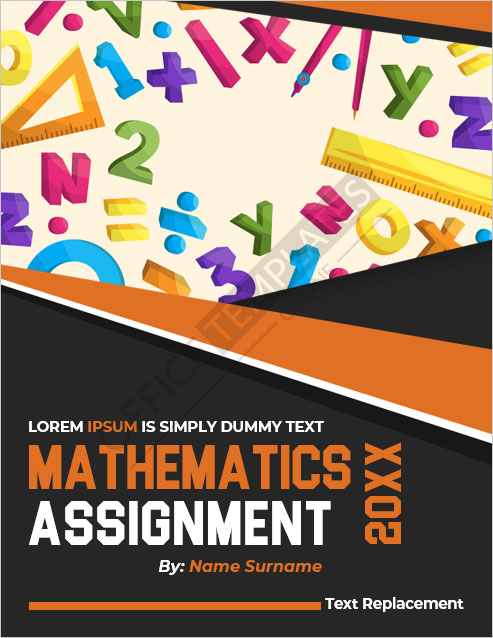
#25 – Physics
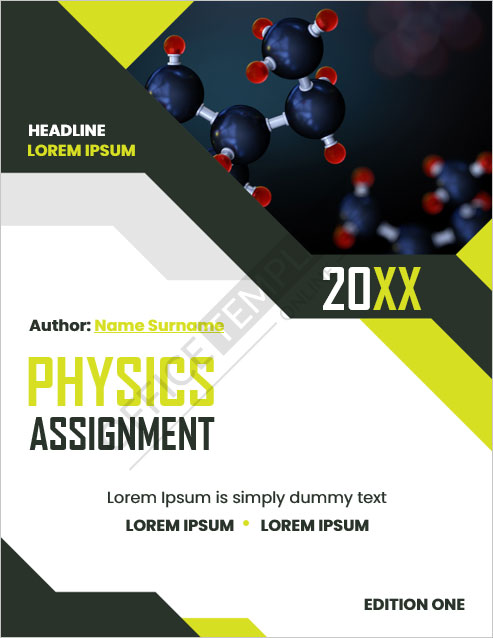
#26 – Cover Page for School Assignments

#27 – Best for Science Projects

#28 – For Social Study Assignment
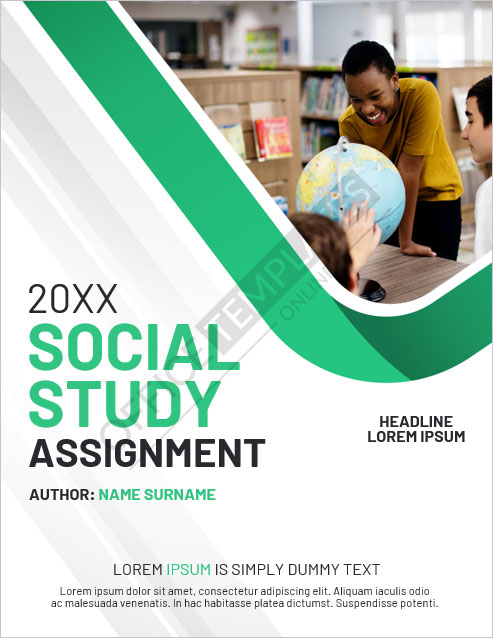
Versatile Designs and Layouts for Every Purpose
- Assignment Types: Our templates are designed specifically for different types of assignments, such as case studies, critical reviews, essays, syllabi, and business projects. Each template is tailored to suit the requirements and objectives of its respective assignment type.
- Academic Disciplines: Our collection includes templates suitable for various academic disciplines like biology, chemistry, computer science, engineering, English, geography, mathematics, physics, and social studies. Each template aligns with the themes and aesthetics of its corresponding discipline.
- Purposes: Whether you are a student, educator, or professional, our templates serve multiple purposes. They can be used for university assignments, school projects, research papers, or any academic or professional endeavor that requires a polished cover page.
- Designs, Layouts, and Styles: Our templates offer a diverse range of designs, from minimalistic and clean to visually captivating and sophisticated. You can choose from different layouts that creatively arrange text, images, and graphics. Our templates cater to a variety of styles, ensuring there is something for everyone’s preferences.
User-Friendly Customization: Make It Your Own
- Easy Modifications: We believe in keeping things simple. With just a few clicks, you can effortlessly modify our templates to suit your specific requirements. Change colors, fonts, and layouts with ease, and watch your cover page transform before your eyes.
- Colors and Themes: Infuse it with the perfect color scheme and themes that truly represent your assignment. Our templates offer a wide range of options, so you can find the ideal palette and theme that resonate with your content.
- Font Selection: The right font can make all the difference. Choose from our diverse selection of fonts to enhance the visual appeal and readability. From elegant and professional to modern and bold, we have fonts to suit every style.
- Layout Flexibility: It should reflect your unique presentation style. With our templates, you have the freedom to experiment with different layouts, arranging titles, subtitles, images, and text blocks in a way that best suits your assignment.
Benefits of Using Professionally Designed Templates: Make an Impact with Ease
- Time and Effort Saving: Our professionally designed templates eliminate the need to start from scratch. With pre-designed layouts, styles, and graphics, you can save valuable time and effort in creating visually appealing front pages. Simply customize the template to suit your assignment’s requirements, and you’re ready to impress.
- Consistency and Professionalism: Using our templates ensures consistency in your assignment submissions. The standardized design elements and formatting guidelines help maintain a professional appearance throughout your work. Presenting your assignments with a polished title page enhances the overall quality and credibility of your content.
- Visual Appeal: A visually appealing title page grabs attention and sets the tone for your assignment. Our templates are thoughtfully crafted by design professionals, incorporating aesthetically pleasing elements, color schemes, and typography. By leveraging these designs, you can effortlessly create eye-catching cover pages that captivate your professors or readers.
- Positive Impression: First impressions matter, and a well-designed cover page leaves a positive impact on professors and readers alike. Showcasing your assignment in a professional and visually appealing manner demonstrates your dedication and attention to detail. It sets the stage for an engaging reading experience, encouraging your audience to delve deeper into your work.
- User-Friendly Customization: Our templates are designed to be easily customizable, allowing you to add your personal touch without technical expertise. You can modify text, colors, images, and other elements to align with your assignment’s theme and requirements. This flexibility ensures that your cover page reflects your unique style while maintaining a professional look.
Tips for Maximizing the Impact: Make Your Cover Page Stand Out
- Choose Colors Wisely: Select colors that complement your assignment’s theme and evoke the desired emotions. Vibrant colors can grab attention, while muted tones create a sense of elegance. Maintain consistency with your assignment’s overall design and avoid using too many colors that may distract from the main message.
- Opt for Legible Fonts: Use clear and readable fonts to enhance the accessibility and professionalism of your cover page. Avoid overly decorative or complex fonts that may hinder readability. Opt for fonts that align with your assignment’s tone and maintain consistency throughout the document.
- Incorporate Relevant Graphics: Graphics can enhance the visual appeal of your cover page and reinforce the assignment’s subject matter. Choose images or icons that are directly related to the topic or convey the assignment’s main concept. Ensure that the graphics are high-quality and appropriately sized to maintain clarity.
- Organize Information Effectively: Arrange the information in a logical and visually appealing manner. Use headings, subheadings, and bullet points to break down content and make it easier to read. Highlight key details such as the assignment title, your name, course information, and submission date.
- Maintain Simplicity: While it’s important to make it visually appealing, avoid cluttering it with excessive elements. Keep the design clean and uncluttered, allowing the key information to stand out. Remember, simplicity often has a greater impact than complexity.
- Preview and Proofread: Before finalizing, preview it to ensure that all elements are properly aligned and visually balanced. Proofread the content to eliminate any spelling or grammatical errors. A polished and error-free cover demonstrates your attention to detail and professionalism.
← Previous Article
Next Article →
You may also like

- Mother’s Day Cards
- Doctor Prescription Pad Formats
- Printable ID Cards
- Creative Resume Formats for Freshers
- Modern Resume Templates
- Best Cover Page Formats
- Printable Report Cards
- Business Proposal Templates
- 22 Raffle Ticket Templates
- Free Certificate Templates
Search the database of 10,000+ templates, designs & formats for Microsoft Office.
- Crafted with Love: Free Mother’s Day Cards to Warm Mom’s Heart
- Stand Out from the Crowd: 6+ Free Fact Sheet Templates
- Make Your Mark: Free Printable Dog Name Tags for Every Tail-Wagger!
- 7+ Free Stunning Easter Templates for Joyful Celebrations
- 9+ Free Admit-One Ticket Templates: Flexible and Easy to Edit
- Get Cooking with Style: 8+ Free Customizable Recipe Card Templates
- 11+ Free Mortgage Flyer Templates to Elevate Your Marketing
- Enhance Your Events with 20+ Unique and Free Ticket Voucher Templates
- Relaxation Redefined: Explore Free 8+ Spa Voucher Templates
- 24+ Free Employment Verification Letter Templates
- Free 5+ Best Christmas Wishlist Templates for Joyful Giving
- 5+ Best FREE Wedding Timeline Templates for a Magical Celebration
- Certificates
- Cover Pages
- Educational
- Event Templates
- Invoices & Receipts
- Letterheads
- Office Related
- Personal Use
- 137+ Professional Reports – MS Word & Excel
- 70+ Printable & Editable ID Card Designs
- 59+ Proposal Formats
- 31+ Best Flyer Designs & Formats
- 100+ Cover Page Templates
- 22+ Free Letterhead Designs and Formats
- 24+ Free Resume Designs & for Freshers and Professionals
- 136+ Printable Certificate Templates
- 55+ Quotations & Invoices
- Create FREE PDF Calendar Online

Want to create or adapt books like this? Learn more about how Pressbooks supports open publishing practices.
Writing Assignments
Lyle Cleeland and Lisa Moody

Introduction
Assignments are a common method of assessment at university and require careful planning and good quality research. Developing critical thinking and writing skills are also necessary to demonstrate your ability to understand and apply information about your topic. It is not uncommon to be unsure about the processes of writing assignments at university.
This chapter has a collection of resources that will provide you with the skills and strategies to understand assignment requirements and effectively plan, research, write, and edit your assignments.
Task Analysis and Deconstructing an Assignment
It is important that you spend sufficient time understanding all the requirements before you begin researching and writing your assignments.
The assessment task description (located in your subject outline) provides key information about an assessment item, including the question. It is essential to scan this document for topic, task, and limiting words. If there are any elements you do not understand, you should clarify these as early as possible.
Make sure you have a clear understanding of what the task word requires you to address.
The marking criteria or rubric , is an important document to look at before you begin your assignment. This outlines how your assignment will be marked and should be used as a checklist to make sure you have included all the information required.
The assessment task description will also include the:
- Word limit (or word count)
- Referencing style and research expectations
- Formatting requirements
For a more detailed discussion on task analysis, criteria sheets, and marking rubrics, visit the chapter Managing Assessments .
Preparing your ideas
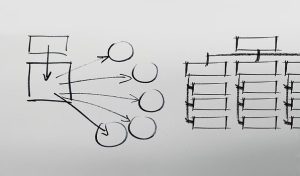
Brainstorm or concept map: List possible ideas to address each part of the assignment task based on what you already know about the topic from lectures and weekly readings.
Finding appropriate information: Learn how to find scholarly information for your assignments which is:
See the chapter Working With Information for a more detailed explanation .
What is Academic Writing?
Academic writing tone and style.
Many of the assessment items you prepare will require an academic writing style. Sometimes this feels awkward when you begin. However, it is good to know that practice at academic writing reduces this feeling.
Thesis statements
One of the most important steps in writing an essay is constructing your working thesis statement. A thesis statement tells the reader the purpose, argument, or direction you will take to answer your assignment question. It is found in the introduction paragraph. The thesis statement:
- Directly relates to the task . Your thesis statement may even contain some of the key words or synonyms from the task description.
- Does more than restate the question.
- Is specific and uses precise language.
- Lets your reader know your position or the main argument that you will support with evidence throughout your assignment.
- The subject is the key content area you will be covering.
- The premise is the key argument or position.
A key element of your thesis statement should be included in the topic sentence of each paragraph.
Planning your assignment structure
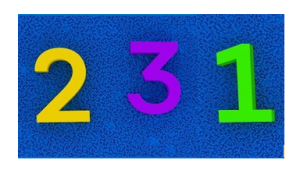
When planning and drafting assignments, it is important to consider the structure of your writing. Academic writing should have a clear and logical structure and incorporate academic research to support your ideas. It can be hard to get started and at first you may feel nervous about the size of the task. This is normal. If you break your assignment into smaller pieces, it will seem more manageable as you can approach the task in sections. Refer to your brainstorm or plan. These ideas should guide your research and will also inform what you write in your draft. It is sometimes easier to draft your assignment using the 2-3-1 approach, that is, write the body paragraphs first followed by the conclusion and finally the introduction.
No one’s writing is the best quality on the first few drafts, not even professional writers. It is strongly advised that you accept that your first few drafts will feel rough. Ultimately, it is the editing and review processes which lead to good quality ideas and writing.
Writing introductions and conclusions
Clear and purposeful introductions and conclusions in assignments are fundamental to effective academic writing. Your introduction should tell the reader what is going to be covered and how you intend to approach this. Your conclusion should summarise your argument or discussion and signal to the reader that you have come to a conclusion with a final statement.
Writing introductions
An effective introduction needs to inform your reader by establishing what the paper is about and provide four basic elements:
- A brief background or overview of your assignment topic and key information that reader needs to understand your thesis statement.
- Scope of discussion (key points discussed in body paragraphs).
- A thesis statement (see section above).
The below example demonstrates the different elements of an introductory paragraph.
1) Information technology is having significant effects on the communication of individuals and organisations in different professions. 2) Digital technology is now widely utilised in health settings, by health professionals. Within the public health field, doctors and nurses need to engage with ongoing professional development relating to digital technology in order to ensure efficient delivery of services to patients and communities. 3) Clearly, information technology has significant potential to improve health care and medical education, but some health professionals are reluctant to use it.
1 Brief background/overview | 2 Scope of what will be covered | 3 The thesis statement
Writing conclusions
You should aim to end your assignments with a strong conclusion. Your conclusion should restate your thesis statement and summarise the key points you have used to prove this thesis. Finish with a key point as a final impactful statement. If your assessment task asks you to make recommendations, you may need to allocate more words to the conclusion or add a separate recommendations section before the conclusion. Use the checklist below to check your conclusion is doing the right job.
Conclusion checklist
- Have you referred to the assignment question and restated your argument (or thesis statement), as outlined in the introduction?
- Have you pulled together all the threads of your essay into a logical ending and given it a sense of unity?
- Have you presented implications or recommendations in your conclusion? (if required by your task).
- Have you added to the overall quality and impact of your essay? This is your final statement about this topic; thus, a key take-away point can make a great impact on the reader.
- Do not add any new material or direct quotes in your conclusion.
This below example demonstrates the different elements of a concluding paragraph.
1) Clearly, communication of individuals and organisations is substantially influenced or affected by information technology across professions. 2) Managers must ensure that effective in-house training programs are provided for public health professionals, so that they become more familiar with the particular digital technologies 3) In addition, the patients and communities being served by public health professionals benefit when communication technologies are effectively implemented. 4) The Australian health system may never be completely free of communication problems, however, ensuring appropriate and timely professional development, provision of resource sand infrastructure will enhance service provision and health outcomes.
1 Reference to thesis statement – In this essay the writer has taken the position that training is required for both employees and employers . | 2-3 Structure overview – Here the writer pulls together the main ideas in the essay. | 4 Final summary statement that is based on the evidence.
Note: The examples in this document are adapted from the University of Canberra and used under a CC-BY-SA-3.0 licence.
Writing paragraphs
Each paragraph should have its own clearly identified Topic Sentence or main idea which relates to the argument or point (thesis) you are developing. This idea should then be explained by additional sentences which you have paraphrased from good quality sources and referenced according to the recommended guidelines of your subject (see the chapter Working with Information ). Paragraphs are characterised by moving from general information to the specific details. A common structure for paragraphs in academic writing is as follows.
Topic Sentence
The first sentence of the paragraph is the Topic Sentence. This is the main idea of the paragraph and tells the reader what you will discuss in more detail below. Each Topic Sentence should address one aspect of your overall argument.
Supporting Sentences
Supporting Sentences provide more explanation, evidence, data, analogies, and/or analysis of the main idea.
Linking/Concluding Sentence
Some paragraphs are best linked to the following paragraph through a Linking/Concluding Sentence. Not every paragraph lends itself to this type of sentence.
Use the checklist below to check your paragraphs are clear and well formed.
Paragraph checklist
- Does your paragraph have a clear main idea?
- Is everything in the paragraph related to this main idea?
- Is the main idea adequately developed and explained?
- Have you included evidence to support your ideas?
- Have you concluded the paragraph by connecting it to your overall topic (where appropriate)?
Writing sentences
Make sure all the sentences in your paragraphs make sense. Each sentence must contain a verb to be a complete sentence. Avoid incomplete sentences or ideas that are unfinished and create confusion for your reader. Also avoid overly long sentences, which happens when you join two ideas or clauses without using the appropriate punctuation. Address only one key idea per sentence. See the chapter English Language Foundations for examples and further explanation.
Use transitions (linking words and phrases) to connect your ideas between paragraphs and make your writing flow. The order that you structure the ideas in your assignment should reflect the structure you have outlined in your introduction. Refer to the transition words table in the chapter English Language Foundations .
Paraphrasing and Synthesising
What is paraphrasing.
Paraphrasing is changing the writing of another author into your words while retaining the original meaning. You must acknowledge the original author as the source of the information in your citation. Follow the steps in this table to help you build your skills in paraphrasing. Note: paraphrasing generally means that the rewritten section is the same or a similar length to the original.
Example of paraphrasing
Please note that these examples and in-text citations are for instructional purposes only.
Original text
Health care professionals assist people, often when they are at their most vulnerable . To provide the best care and understand their needs, workers must demonstrate good communication skills . They must develop patient trust and provide empathy to effectively work with patients who are experiencing a variety of situations including those who may be suffering from trauma or violence, physical or mental illness or substance abuse (French & Saunders, 2018).
Poor quality paraphrase example
This is a poor example of paraphrasing. Some synonyms have been used and the order of a few words changed within the sentences. However, the colours of the sentences indicate that the paragraph follows the same structure as the original text.
Health care sector workers are often responsible for vulnerable patients. To understand patients and deliver good service , they need to be excellent communicators . They must establish patient rapport and show empathy if they are to successfully care for patients from a variety of backgrounds and with different medical, psychological and social needs (French & Saunders, 2018).
A good quality paraphrase example
This example demonstrates a better quality paraphrase. The author has demonstrated more understanding of the overall concept in the text by using the keywords as the basis to reconstruct the paragraph.
Empathetic communication is a vital skill for health care workers. Professionals in these fields are often responsible for patients with complex medical, psychological and social needs. Empathetic communication assists in building rapport and gaining the necessary trust to assist these vulnerable patients by providing appropriate supportive care (French & Saunders, 2018).
The good quality paraphrase example demonstrates understanding of the overall concept in the text by using key words as the basis to reconstruct the paragraph. Note how the blocks of colour have been broken up to see how much the structure has changed from the original text.
What is synthesising?
Synthesising means to bring together more than one source of information to strengthen your argument. Once you have learnt how to paraphrase the ideas of one source at a time, you can consider adding additional sources to support your argument. Synthesis demonstrates your understanding and ability to show connections between multiple pieces of evidence to support your ideas and is a more advanced academic thinking and writing skill.
Follow the steps in this table to improve your synthesis techniques.
Example of synthesis
There is a relationship between academic procrastination and mental health outcomes. Procrastination has been found to have a negative effect on students’ well-being (Balkis, & Duru, 2016). Yerdelen et al.’s (2016) research results suggest that there is a positive association between procrastination and anxiety. This is corroborated by Custer’s (2018) findings which indicate that students with higher levels of procrastination also report greater levels of anxiety. Therefore, it could be argued that procrastination is an ineffective learning strategy that leads to increased levels of distress.
Topic sentence | Statements using paraphrased evidence | Critical thinking (student voice) | Concluding statement – linking to topic sentence
This example demonstrates a simple synthesis. The author has developed a paragraph with one central theme and included explanatory sentences complete with in-text citations from multiple sources. Note how the blocks of colour have been used to illustrate the paragraph structure and synthesis (i.e. statements using paraphrased evidence from several sources). A more complex synthesis may include more than one citation per sentence.
Paraphrasing and synthesising are powerful tools that you can use to support the main idea of a paragraph. It is likely that you will regularly use these skills at university to incorporate evidence into explanatory sentences and strengthen your essay. It is important to paraphrase and synthesise because:
- Paraphrasing is regarded more highly at university than direct quoting.
- Paraphrasing can also help you better understand the material.
- Paraphrasing and synthesising demonstrate that you have understood what you have read through your ability to summarise and combine arguments from the literature using your own words.
Creating an Argument
What does this mean.
In academic writing, if you are asked to create an argument, this means you are asked to have a position on a particular topic, and then justify your position using evidence from valid scholarly sources.
What skills do you need to create an argument?
In order to create a good and effective argument, you need to be able to:
- Read critically to find evidence.
- Plan your argument.
- Think and write critically throughout your paper to enhance your argument.
For tips on how to read and write critically, refer to the chapter Thinking for more information. A formula for developing a strong argument is presented below.
A formula for a good argument
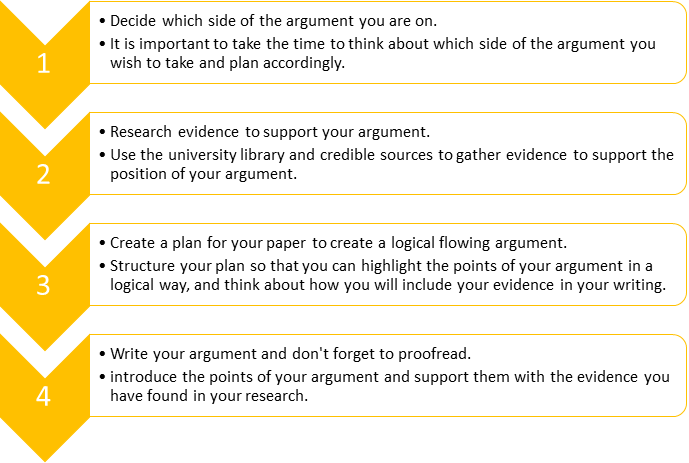
What does an argument look like?
As can be seen from the figure above, including evidence is a key element of a good argument. While this may seem like a straightforward task, it can be difficult to think of wording to express your argument. The table below provides examples of how you can illustrate your argument in academic writing.
Editing and proofreading (reviewing)
Once you have finished writing your first draft it is recommended that you spend time revising your work. Proofreading and editing are two different stages of the revision process.
- Editing considers the overall focus or bigger picture of the assignment.
- Proofreading considers the finer details.
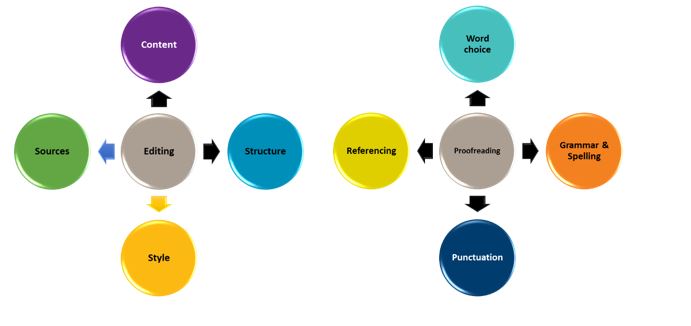
As can be seen in the figure above, there are four main areas that you should review during the editing phase of the revision process. The main things to consider when editing include content, structure, style, and sources. It is important to check that all the content relates to the assignment task, the structure is appropriate for the purposes of the assignment, the writing is academic in style, and that sources have been adequately acknowledged. Use the checklist below when editing your work.
Editing checklist
- Have I answered the question accurately?
- Do I have enough credible, scholarly supporting evidence?
- Is my writing tone objective and formal enough or have I used emotive and informal language?
- Have I written in third person, not first person?
- Do I have appropriate in-text citations for all my information?
- Have I included the full details for all my in-text citations in my reference list?
During proofreading, it is important to check your work for word choice, grammar and spelling, punctuation, and referencing errors. It can be easy to mis-type words like ‘from’ and ‘form’ or mix up words like ‘trail’ and ‘trial’ when writing about research, apply American rather than Australian spelling, include unnecessary commas, or incorrectly format your references list. The checklist below is a useful guide that you can use when proofreading your work.
Proofreading checklist
- Is my spelling and grammar accurate?
- Are they complete?
- Do they all make sense?
- Do the different elements (subject, verb, nouns, pronouns) within my sentences agree?
- Are my sentences too long and complicated?
- Do they contain only one idea per sentence?
- Is my writing concise? Take out words that do not add meaning to your sentences.
- Have I used appropriate discipline specific language but avoided words I don’t know or understand that could possibly be out of context?
- Have I avoided discriminatory language and colloquial expressions (slang)?
- Is my referencing formatted correctly according to my assignment guidelines? (For more information on referencing, refer to the Managing Assessment feedback section).
This chapter has examined the experience of writing assignments. It began by focusing on how to read and break down an assignment question, then highlighted the key components of essays. Next, it examined some techniques for paraphrasing and summarising, and how to build an argument. It concluded with a discussion on planning and structuring your assignment and giving it that essential polish with editing and proofreading. Combining these skills and practising them can greatly improve your success with this very common form of assessment.
- Academic writing requires clear and logical structure, critical thinking and the use of credible scholarly sources.
- A thesis statement is important as it tells the reader the position or argument you have adopted in your assignment.
- Spending time analysing your task and planning your structure before you start to write your assignment is time well spent.
- Information you use in your assignment should come from credible scholarly sources such as textbooks and peer reviewed journals. This information needs to be paraphrased and referenced appropriately.
- Paraphrasing means putting something into your own words and synthesising means to bring together several ideas from sources.
- Creating an argument is a four step process and can be applied to all types of academic writing.
- Editing and proofreading are two separate processes.
Balkis, M., & Duru, E. (2016). Procrastination, self-regulation failure, academic life satisfaction, and affective well-being: underregulation or misregulation form. European Journal of Psychology of Education, 31 (3), 439-459.
Custer, N. (2018). Test anxiety and academic procrastination among prelicensure nursing students. Nursing Education Perspectives, 39 (3), 162-163.
Yerdelen, S., McCaffrey, A., & Klassen, R. M. (2016). Longitudinal examination of procrastination and anxiety, and their relation to self-efficacy for self-regulated learning: Latent growth curve modeling. Educational Sciences: Theory & Practice, 16 (1), 5-22.
Writing Assignments Copyright © 2023 by Lyle Cleeland and Lisa Moody is licensed under a Creative Commons Attribution-NonCommercial-ShareAlike 4.0 International License , except where otherwise noted.
Course Resources
Discussions and assignments.

The assignments in this course are openly licensed, and are available as-is, or can be modified to suit your students’ needs.
If you import this course into your learning management system (Blackboard, Canvas, etc.), the assignments will automatically be loaded into the assignment tool. The assignment pages within each module link to the live assignment page. You can view them below or throughout the course. There is at least one discussion and one assignment ready to be used in every module of the course. We do not recommend assigning them all, however, and recommend selecting those that work best for you . If you choose to assign the capstone project (explained below), we suggest excluding some of the other assignments so that students have sufficient time to prepare for their capstone work.
To make edits or customized versions of the assignments, we recommend copying and pasting the discussion or assignment text directly into your LMS discussion or assignment page in order to make changes.
Capstone Project
The capstone project is an optional comprehensive assignment that could be assigned to students to complete progressively through the course. The assignment is divided into 3 to 4 pieces and culminates in students creating a PechaKucha presentation.
For this capstone project, students will pick a reformer or activist involved with a progressive or social movement between 1877 and 2000. They will evaluate and analyze the ideas, agenda, strategies, and effectiveness of the work done by their chosen reformer or activist in order to make a claim and present on their findings in the form of a PechaKucha presentation (or another pre-approved format). PechaKucha presentations follow a 20×20 presentation format, meaning that a presenter chooses 20 images and speaks about each image for 20 seconds (totaling 6 minutes at 40 seconds).
The capstone project components are shared as assignments that link to Google Documents. You can make a copy of those documents to customize them. To do so, open the Google Doc and choose “File -> Make a copy” to create your own version.
- Part 0: Social Media Activism (also found as an assignment in Module 5)
- Part 1: Research and Annotated Bibliography
- Part 2: Draft PechaKucha Outline
- Part 3: Submit Final PechaKucha Presentation
- Assignments. Provided by : Lumen Learning. License : CC BY: Attribution
- Pencil Cup. Authored by : IconfactoryTeam. Provided by : Noun Project. Located at : https://thenounproject.com/term/pencil-cup/628840/ . License : CC BY: Attribution
Our office will be open virtually on Mondays and and Fridays during the summer. Resume drop-in hours will resume in the fall. Have a great summer!
- Schedule an Appointment
- Undergraduate Students
- Graduate Students
- Faculty & Staff
- Prospective Students
- Parents & Families
- Career Champions
- African Heritage
- Asian, Pacific Islander Heritage
- First Generation
- Indigenous/Native American Heritage
- International
- LatinX Heritage
- Non-Traditional Student
- Students with Disabilities
- Undocumented
- Arts, Media, Marketing & Communications
- Business Management & Administration
- Education, Training, Non-profit & Social Justice
- Finance & Accounting
- International Affairs
- Health Sciences
- Human Services
- Information Technology, Systems, and Computer-Related Fields
- Languages & Cultures
- Law, Government, Policy & Public Administration
- Sustainability
- Undecided/Exploring
- Explore Your Interests, Majors and Careers
- Create a Resume / Cover Letter
- Prepare for an Interview/Negotiate an Offer
- Networking/Career Fairs
- Search for a Job / Internship
- Apply to Graduate School
- Community Service
- Center for Leadership and Service
- Internships for Academic Credit
- Study Abroad
- May 2020 Outcome Data
- May 2021 Outcome Data
- May 2022 Outcome Data
Assignment: Career Readiness using Focus 2
- Share This: Share Assignment: Career Readiness using Focus 2 on Facebook Share Assignment: Career Readiness using Focus 2 on LinkedIn Share Assignment: Career Readiness using Focus 2 on X
Focus2 is a free online assessment tool for all UAlbany students. It includes several career assessments that help students choose careers and majors. It also has an assessment of the student’s Career Readiness based on the NACE Career Competencies. This assignment focusses on assessing and developing a student’s career readiness.
Research Administrator 2 - TP129839
Job description, #tp129839 research administrator 2.
Position available through UCSD Temporary Employment Services (TES). Employment through TES is an excellent way to gain valuable UCSD experience and get your foot in the door for career positions. TES employment includes medical coverage, paid vacation & sick time, paid holidays, as well as training and development opportunities!
ASSIGNMENT DETAILS
UC San Diego is hiring a temporary Research Administrator 2 to support campus operations for the 2023 - 2024 School Year.
Duration: This role is anticipated to last 3 months
Compensation: $29.60 - $32.00 / hour. Eligible for paid holidays and vacation/sick leave. Full-medical insurance also available.
Work Schedule: Hybrid M-F 8-4:30pm, 1-2 days on-site
Location: On campus in La Jolla.
Join our esteemed team at UC San Diego as a temporary Research Administrator, specializing in Post-Award Management, where you'll play a pivotal role in facilitating the success of our faculty's research initiatives. As a Research Administrator, you will primarily focus on overseeing the financial portfolios of designated faculty members after the award stage, ensuring compliance with grant and contract guidelines while providing strategic guidance on budget projections and spending.
JOB DESCRIPTION
Spearhead the management of post-award financial portfolios for assigned faculty members, ensuring adherence to grant and contract regulations.
Navigate financial transactions through UCPath with precision, maintaining meticulous records and upholding compliance standards.
Provide invaluable support in forecasting budget projections and advising faculty members on strategic resource allocation.
Utilize advanced spreadsheet and database software for comprehensive financial analyses and reports, demonstrating proficiency in fiscal management practices.
Thrive in a fast-paced environment with overlapping deadlines, consistently upholding a high level of accuracy and attention to detail.
Serve as a knowledgeable resource on policy guidelines, interpreting and applying them effectively to support faculty members and colleagues.
QUALIFICATIONS
- Extensive experience in financial analysis and reporting using spreadsheet and database software.
In-depth understanding of generally accepted accounting principles and fiscal management practices within a research administration context.
Proven track record of effective problem-solving in a fast-paced, deadline-driven environment.
Demonstrated expertise in interpreting and applying policy guidelines related to post-award grant and contract management.
Proficiency in basic Excel functions, including filtering, sorting, and basic calculations, with a willingness to further develop skills as needed.
Comfortable navigating computer systems and e-filing procedures, with a clear understanding of desktop and download folder distinctions.
While training opportunities will be available, candidates should demonstrate proficiency in policy interpretation and basic Excel skills.
Preference will be given to candidates with a background in Post-Award Management, Research Administration, or related fields, such as Higher Education Grants, Financial Analysis, or Accounting.
The successful candidate will bring a strong foundation in fiscal management practices and a commitment to supporting our faculty's research endeavors.
SPECIAL CONDITIONS
Background check required
This position has been identified as a Mandated Reporter pursuant to the California Child Abuse and Neglect Reporting Act (CANRA) and requires immediate reporting of physical abuse, sexual abuse, emotional abuse, or neglect of anyone under the age of 18. It is the responsibility of the Mandated Reporter to ensure that they obtain proper training in order to fulfill their reporting responsibilities as required by the California Child Abuse and Neglect Reporting Act and University policy, and to complete and submit the required reports to the UC San Diego Police Department without delay.
Pay Transparency Act
Annual Full Pay Range: $61,800 - $108,000 (will be prorated if the appointment percentage is less than 100%)
Hourly Equivalent: $29.60 - $51.72
Factors in determining the appropriate compensation for a role include experience, skills, knowledge, abilities, education, licensure and certifications, and other business and organizational needs. The Hiring Pay Scale referenced in the job posting is the budgeted salary or hourly range that the University reasonably expects to pay for this position. The Annual Full Pay Range may be broader than what the University anticipates to pay for this position, based on internal equity, budget, and collective bargaining agreements (when applicable).
If employed by the University of California, you will be required to comply with our Policy on Vaccination Programs, which may be amended or revised from time to time. Federal, state, or local public health directives may impose additional requirements.
To foster the best possible working and learning environment, UC San Diego strives to cultivate a rich and diverse environment, inclusive and supportive of all students, faculty, staff and visitors. For more information, please visit UC San Diego Principles of Community .
UC San Diego is an Equal Opportunity/Affirmative Action Employer. All qualified applicants will receive consideration for employment without regard to race, color, religion, sex, sexual orientation, gender identity, national origin, disability, age or protected veteran status.
For the University of California’s Affirmative Action Policy please visit: https://policy.ucop.edu/doc/4010393/PPSM-20 For the University of California’s Anti-Discrimination Policy, please visit: https://policy.ucop.edu/doc/1001004/Anti-Discrimination
UC San Diego is a smoke and tobacco free environment. Please visit smokefree.ucsd.edu for more information.
Application Instructions
Please click on the link below to apply for this position. A new window will open and direct you to apply at our corporate careers page. We look forward to hearing from you!
Share This Page
Posted : 5/13/2024
Job Reference # : TP129839
JOIN OUR TALENT COMMUNITY
Interested in working at UC San Diego and UC San Diego Health but can't find a position that's right for you? Submit your resume to our Talent Community to be considered for future opportunities that may align with your expertise. Please note, by joining our Talent Community, you are not applying for a position with UC San Diego Campus and Health. Rather, this is an additional way for our Talent Acquisition team to find candidates with specific credentials, if an opportunity arises. You are still encouraged to regularly check back on our career site or sign up for Job Alerts to apply for openings that are a match for your background.
- Career Sites by Recruiting.com
Working with Assignments > Taking a Homework or Test Assignment
Taking a Homework or Test Assignment This section provides step-by-step instructions on how to take a Homework or Test. These assignment types permit you to work through the questions in any order. Your instructor's settings will determine the features appearing in your assignment. For example, your instructor can control if you are able to check your work, send an email from your take, print questions, see feedback, or save and resume your assignment at a later time. Note: Assignments that start with a quiz and provide a customized study plan are called Adaptive Study Plans or "Study Tools" assignments. See Taking Adaptive Study Plans Assignments for more information. Questions can appear in a variety of formats. For Multiple Choice and True/False questions, you select a choice from a list. For other question formats, you may need to enter multiple answers, type short essay responses, or link matching items with your mouse. To start an assignment 1. Click the Assignments link to open the Assignments page. 2. Make a selection from the Course or Section dropdown menu (if necessary). 3. Use the links on the Assignments page to display your course assignments in the most useful way. See Using the Assignments Page for details. 4. Open the Assignment Ready page by clicking an option in the Actions column: Take . Begin taking a graded assignment for the first time. Practice . Begin taking an ungraded assignment. Depending on your instructors settings, this can also be an assignment you completed for a grade. Resume . Continues an assignment started previously and saved in progress. (Not all assignments can be saved and resumed.) Retake . Retake an assignment that you've previously completed. If a password is required, type it into the Password field. Note: An assignment may no longer be available, if you have taken it the maximum number of times, if your instructor has taken if offline, or if it is past its due date. If your instructor has set an Unavailable Date and you have not yet scored 100%, you can take an assignment past its due date (although there is generally a penalty). Before beginning your assignment, review the Assignment Ready page for instructions or any special conditions that apply to your assignment. 5. Click the Start Assignment Now button to begin taking the assignment. You can use the Cancel button to return to the Assignments page instead. By doing so, the assignment is not counted as taken. Note: The start button label may vary slightly, depending on assignment type or status. 6. Begin answering questions once your assignment or test is completely loaded. To answer questions The series of steps below start from the beginning of your assignment take. Use the steps outlined above to load your assignment. Warning: During an assignment, never close your browser, go to another site, or use your browser's forward and back buttons—you will lose your current work, and your attempt is counted as one of your allowed "Takes." Use only the CengageNOWv2 navigation buttons and links. Be sure each page loads completely before proceeding. 1. Read each question carefully for special instructions, and answer as directed. 2. Evaluate the correctness of your current answer by clicking the Check My Work button (in questions that provide it). This displays a collapsible feed back window where you can see if your answer is "correct," "partially correct," or "incorrect" in addition to additional feedback. This option allows you to improve your answer before submitting the assignment for grading. Feedback icons which evaluate your work can include the following: ° Correct ° Incorrect ° Partially Correct - The answer has one or more elements that are incomplete or incorrect. ° Needs Instructor Grading - The answer you entered must be evaluated later by your instructor. 3. When available, you can click the arrow icons on the Feedback window to collapse or expand either the entire window or individual feedback sections. 4. ( Optional ) Click the Calculator icon to open a basic calculator. You can reposition the calculator window within your browser. 5. ( Optional ) If your instructor has enabled it, you can click Print Item in the heading to print a copy of the current question. Note: Printing items does not work for Flash-based items such as General Ledger (CLGL). 6. Click Hints or Show Additional Info (when available) to get help with answering your question. Note: Depending on your assignment's settings, you may also see options for other resources such as your eBook , turning on Audio , related Exercises , Show Me How videos, Dynamic Exhibits , and Spreadsheets . 7. Questions with multiple answers may provide a Clear All link, which allows you to let you start that question over. 8. Click a number in the Questions column, if you are not automatically advanced to the next question. You can also use the arrow controls in the lower right corner of the page to go to the previous question or the next question in sequence. You can work through most questions in any order. This makes it easy to answer skipped questions and change your previous answers before submitting the assignment for grading. 9. ( Optional ) Email Instructor - When available, you can use this feature to send a question by email that supplies your instructor with a view of the specific assignment content on which you are working. 10. ( Optional ) Contact Technical Support - In assignments that provide it, click this button to open the Cengage support site in a new browser window. 11. When permitted, you can click the Save and Exit button to finish your assignment in a later session. Note: An assignment may no longer be available, if you have taken it the maximum number of times or if it is past its due date. However, if your instructor has set an Unavailable Date and you have not yet scored 100%, you can take an assignment past its due date (generally with a penalty). 12. When you are completely finished with all sections of the assignment, click the Submit Assignment for Grading button (labeled Submit Assignment for Practice work or Submit Test for Grading for tests). The Submit Assignment for Grading? message window opens so that you can confirm you are ready to turn in the assignment. It will also caution you if any answers are still incomplete and give you an option to continue the assignment. 13. Click Submit for Grading to confirm you want to submit your assignment and exit. Click Continue Taking Assignment to cancel the submission and return to the assignment take. Caution: Each time you click Submit Assignment for Grading , you use one of your available takes. Many assignments are set up to permit only one take. The Assignment Finished or Test Finished page opens to give you several options for your next step. Depending on the assignment settings, you may be able to see your overall score, click View Assignment Results to review your answers (if allowed by your instructor), Take This Assignment Again (if multiple takes are allowed), or Go Back to the Assignments List . To save a partially finished assignment Use these instructions when your instructor has set up your assignment so you can stop the current take and finish it at another time. You will see a Save and Exit button when this option is available. Once saved, your assignment will continue to appear on the Assignments page with a Resume button for starting your take. Your assignment will continue to be available until the Due Date or Unavailable Date has passed. 1. Click the Save and Exit button on your assignment take page to automatically leave and save your assignment. The Assignment Saved page will open. 2. Choose between the options to Go Back to the Assignments List or Resume This Assignment . You can also open your assignment later by clicking the Resume button on the Assignments page. Note: Your assignment may no longer be available if you have taken it the maximum number of times or if it is past its due date. When your instructor sets an Unavailable Date and you have not yet scored 100%, you can continue to take an assignment past its due date (generally with a late penalty). To review your answers From the Assignments page: 1. Use the tools in the Assignments page to organize your course assignments in the most useful way. See Using the Assignments Page . 2. Select All Assignments and click the number or status provided in the Score column to open the View Assignment Results page (when your instructor has allowed this option). See Using the View Assignment Results Page for more details. From the Assignment Finished page: 1. Click View Assignment Results . 2. The View Assignment Results page opens. See Using the View Assignment Results Page for more details. Note: The availability of your assignment results can depend on the status of questions that require manual grading or how your instructor set up the assignment permissions. To print your assignment From the Assignments page you may be able to print a blank copy of your assignment. 1. Use the tools in the Assignments page to display your course assignments in the most useful way. See Using the Assignments Page for more details. 2. Click the Print blank assignment button for the assignment you want to print and the assignment will appear in a new browser window. 3. Click the Print button to open your browser's your printing preferences. 4. Click Print again once your preferences are set. Note: You can print your assignments only if your instructor set the permission to allow it.
- Administering Oracle Fusion Analytics Warehouse
- Manage Users, Groups, Application Roles, and Data Access
Manage Data Access through Security Assignments
As a security administrator, you need to map data security assignments to users to enable data level access.
Use the Security Assignments tab on the Security page to search for the currently set up data security assignments. You may either search for all records or narrow your search to a specific security context, security value, or user. You can remove a security assignment that you had set up or add new security assignments to a user.
Create a Security Assignment
Delete a security assignment, remove users from a security assignment, manage users for a security assignment, set exclusion rules for security assignments, update security assignments automatically.
Use these instructions to create a security assignment in a specific security context.
- Sign in to your service.
- In Oracle Fusion Analytics Warehouse Console , click Security under Service Administration . You see the Security page.
- On the Security page, click the Security Assignments tab. You see all users who have been granted the security assignments in a specific security context.
- Click New Assignment .
- In New Security Assignment, under Select Security Assignments , select a security context, and then search for a security value or select from the displayed list.Move the selected security assignments to the column on the right.
- Under Select Users , search for a user and select the user and move the user to the column on the right. Users are filtered based on the role associated with that context.
- Click Add to Cart and then click View Cart .
- In Security Assignments, click Apply Assignments . You can grant this security assignment to other users as required. Bulk assignments may take some time to process. See the Security Activity tab for details.
Use these instructions to delete a security assignment. When you delete a security assignment, Oracle Fusion Analytics Warehouse removes all users associated with the security assignment.
- On the Security page, click the Security Assignments tab.
- Select a security assignment from the displayed list of assignments or search for a security assignment and select it.
- Click Delete Assignment .
You can revoke the security assignment granted to one or more users.
- In the security assignment details region, select the users from the displayed list of users or search for and select the users.
- Click Remove User .
- In Revoke User Assignment, click Revoke Assignment .
As a security administrator, you can manage users for existing data security assignments. In the Manage Users dialog, you can revoke users for an existing assignment or add new users for that assignment.
- In the security assignment details region, click Manage Users .
- Under Add User , search for a user and select the user.
- Under User , click the Delete icon to revoke the user from the assignment.
- Click Save .
You can set up data security to exclude access for specific users within a security context for specific security assignments.
For example, you can grant access to all security assignments but the business unit ABC. This enables you to have a single rule for a single user within a security context. You can also remove the indirectly derived security assignments of the specific user. Ensure that the users for whom you want to exclude assignments are members of a group related to the security context. You can automate the application of the security exclusion rules by downloading the DataSecurityExclusionAssignments_csv.zip, making changes, and then uploading it; see Download and Upload Data Security Exclusion Rules .
- In Oracle Fusion Analytics Warehouse Console , click Security under Service Administration.
- On the Security page, click Security Assignments , and then click Exclusion Rules .

As a security administrator, automate the updating of security assignments to effectively manage the regular security assignment changes in your organization.
If you want to automate the insertion and deletion of data in the format of USERNAME, SEC_OBJ_CODE, SEC_OBJ_MEMBER_VAL, Operation (to add or to remove the mapping), then configure the changes in the security assignments to be updated automatically and regularly.
To ensure that the changes in security assignment are updated automatically, you must create a table for the OAX_USER schema in Oracle Autonomous Data Warehouse associated with your Oracle Fusion Analytics Warehouse instance. Ensure that you name the table "CUSTOMER_FAW_CONTENT_AUTOSYNC_ASSIGNMENT". You must seed data into this table regularly with the timestamp in universal time (UTC) format in the "CREATION_DATE" column of the table. The CREATION_DATE column ensures that the same records aren't processed repeatedly and no record is missed. Oracle Fusion Analytics Warehouse periodically scans the synonym (2 hours once), pick up the values, and based on the "CREATION_DATE" criteria, populates the FAW_CONTENT_AUTOSYNC_ASSIGNMENT table in the OAX$INFRA schema in Oracle Autonomous Data Warehouse . Later, Oracle Fusion Analytics Warehouse processes the data and uploads the security assignments as per the FAW_CONTENT_AUTOSYNC_ASSIGNMENT table.
- In Oracle Autonomous Data Warehouse associated with your Oracle Fusion Analytics Warehouse instance, create the CUSTOMER_FAW_CONTENT_AUTOSYNC_ASSIGNMENT table in OAX_USER schema using the following script: CREATE TABLE CUSTOMER_FAW_CONTENT_AUTOSYNC_ASSIGNMENT ( "USERNAME" VARCHAR2(256 CHAR), "SEC_OBJ_CODE" VARCHAR2(256 CHAR), "SEC_OBJ_MEMBER_VAL" VARCHAR2(4000 CHAR), "OPERATION_TYPE" VARCHAR2(65 CHAR), "CREATION_DATE" TIMESTAMP(6) ); -- Grant access from the schema OAX_USER GRANT SELECT ON CUSTOMER_FAW_CONTENT_AUTOSYNC_ASSIGNMENT TO OAX$INFRA; COMMIT;
- In the CUSTOMER_FAW_CONTENT_AUTOSYNC_ASSIGNMENT table, specify the actual values for "USERNAME", "SEC_OBJ_CODE", "SEC_OBJ_MEMBER_VAL", "OPERATION_TYPE", and "CREATION_DATE". For "OPERATION_TYPE", enter "ADD" and enter the timestamp in "CREATION_DATE" in "2024-02-21 12:34:56.789" format.

IMAGES
VIDEO
COMMENTS
Assignment due date. Page number 1 in the top right corner of the page header. The format for the byline depends on whether the paper has one author, two authors, or three or more authors. When the paper has one author, write the name on its own line (e.g., Jasmine C. Hernandez).
What this handout is about. The first step in any successful college writing venture is reading the assignment. While this sounds like a simple task, it can be a tough one. This handout will help you unravel your assignment and begin to craft an effective response. Much of the following advice will involve translating typical assignment terms ...
Follow the guidelines described next to format each element of the student title page. Place the title three to four lines down from the top of the title page. Center it and type it in bold font. Capitalize major words of the title. Place the main title and any subtitle on separate double-spaced lines if desired.
For Module 2, Assignment 2, you will find articles and create a bibliography, including a 1 1/2 - 2 page annotation for one article. This guide covers some strategies you can use to search for articles on your topic: Select search keywords; Build a search in the library databases; Identify research studies (empirical articles) Create your ...
3. Identify the Action Words. Next, underline or highlight all the action words in the assignment directions. Action words tell you what you need to do in your assignment. The number of action words will often tell you how many steps or parts you need to complete for that assignment. For Example.
Planning your assignment carefully and presenting arguments step-by-step is necessary to succeed with your homework. When going through your references, note the questions that appear and answer them, building your text. Create a cover page, proofread the whole text, and take care of formatting.
Types of Assignments Cristy Bartlett and Kate Derrington. Figure 20.1 By recognising different types of assignments and understanding the purpose of the task, you can direct your writing skills effectively to meet task requirements. Image by Armin Rimoldi used under CC0 licence. Introduction. As discussed in the previous chapter, assignments are a common method of assessment at university.
1. Read the assignment carefully as soon as you receive it. Do not put this task off—reading the assignment at the beginning will save you time, stress, and problems later. An assignment can look pretty straightforward at first, particularly if the instructor has provided lots of information.
Figure 19.3 It is sometimes easier to draft your assignment using the 2-3-1 approach. Image by Sam Karanja used under CC0 licence. When planning and drafting assignments, it is important to consider the structure of your writing. Academic writing should have clear and logical structure and incorporate academic research to support your ideas.
Consider the assignment in relation to previous and upcoming assignments. Ask yourself what is new about the task you're setting out to do. Instructors often design assignments to build in complexity. ... 2. Analyze two of Chaucer's Canterbury Tales, including one not discussed in class, as literary works and in terms of sources/analogues.
1. Margins: Leave one-inch margins on all sides of your cover page to give it a neat look and provide space for your text. 2. Font: Stick to Times or Times New Roman font in 12 pt size for a professional appearance that's easy to read. 3. Spacing: Double-space the text on your cover page to make it clear and readable.
Essay Assignment PROMPT & DIRECTIONS. Writing Prompt: Write an essay of 700-900 words (approximately 3 pages double spaced, Times New Roman, 12 pt.) in which you make an argument that gives a word or phrase a clear and original meaning, significance, and/or explanation. Your main argument could re-define and re-explain a term in one of several way. For instance, your argument may follow one of ...
Your document must have 1" (one inch) page margins on the top, sides, and bottom of the document. How to Check the Page Margin Size. Click the "Layout" tab (A) in Microsoft Word, and click the "Margins" drop-down arrow (B). Click on the "Normal (2.54 cm)" margin selection (C), as pictured in Figure 2. Figure 2 - How to Check the ...
Templates for college and university assignments. Include customizable templates in your college toolbox. Stay focused on your studies and leave the assignment structuring to tried and true layout templates for all kinds of papers, reports, and more. Category. Color. Create from scratch. Show all.
Assignment cover pages are very useful and can be created in MS Word or Adobe. MS Word software allows pictures and text to be used on the cover page. Students may also use headers and footers, page borders and other features in MS Word to create a nice cover page. You can even use the popular heading styles given in MS Word.
Easily distribute, analyze, and grade student work with Assignments for your LMS. Assignments is an application for your learning management system (LMS). It helps educators save time grading and guides students to turn in their best work with originality reports — all through the collaborative power of Google Workspace for Education. Get ...
To start an assignment. 1. Click the Assignments link to open the Assignments page. 2. Use the tools on the Assignments page to display your assignments in the most useful way. See Using the Assignments Page for details. 3. Open the Assignment Ready page by clicking an option in the Actions column: Take.
Assignment 2: Exploratory Data Analysis. In this assignment, you will identify a dataset of interest and perform an exploratory analysis to better understand the shape & structure of the data, investigate initial questions, and develop preliminary insights & hypotheses. ... This page lists data from all of their papers, broken down by ...
Download Free Cover Page Templates. Explore our collection of 23 beautifully designed cover page templates in Microsoft Word format. These templates feature captivating colors and layouts that are sure to make a lasting impression. Simply click on the preview image of each template and download it for free.
It is sometimes easier to draft your assignment using the 2-3-1 approach. Image by Sam Karanja used under CC0 licence. When planning and drafting assignments, it is important to consider the structure of your writing. Academic writing should have a clear and logical structure and incorporate academic research to support your ideas.
The assignments in this course are openly licensed, and are available as-is, or can be modified to suit your students' needs. If you import this course into your learning management system (Blackboard, Canvas, etc.), the assignments will automatically be loaded into the assignment tool. The assignment pages within each module link to the live ...
ASK is the Army's online portal for enlisted talent management, where NCOs can preference their assignments and see the matches based on their skills and preferences. Learn more about ASK-EM, the new initiative that simplifies the assignment process and improves readiness and stability for NCOs and their families.
Focus2 is a free online assessment tool for all UAlbany students. It includes several career assessments that help students choose careers and majors. It also has an assessment of the student's Career Readiness based on the NACE Career Competencies. This assignment focusses on assessing and developing a student's career readiness.
Week 2 Assignment 2 Introduction Regarding the topic of childhood education, there is a pressing subtopic to it and that is the use of screentime and when it can be considered excessive. This issue is complex and layered. As a mother of a 2-year-old, I fear the hinderance of my child's Cognitive development, social interactions, and overall well-being.
ASSIGNMENT DETAILS. UC San Diego is hiring a temporary Research Administrator 2 to support campus operations for the 2023 - 2024 School Year. Duration: This role is anticipated to last 3 months. Compensation: $29.60 - $32.00 / hour. Eligible for paid holidays and vacation/sick leave. Full-medical insurance also available.
Join the Teaching, Learning and Technology Center on Thursday, June 6, for an immersive and dynamic day focused on new approaches to assessment. The remote, full-day workshop series will delve into various topics, including the art of designing engaging video and digital story assignments; harnessing the power of ePortfolios to showcase student learning; exploring how to incorporate AI ...
To start an assignment. 1. Click the Assignments link to open the Assignments page. 2. Make a selection from the Course or Section dropdown menu (if necessary). 3. Use the links on the Assignments page to display your course assignments in the most useful way. See Using the Assignments Page for details. 4.
Assignment 2 (40%) - Systematic review (Group) - Detailed guidelines Due by Friday, 10 th May, 10:00am (morning) Submit via Upload files to Assignment 2 on Mylo Things to submit 1.) Response to all the questions (please enter a cover page with names and student IDs of all group members) 2.) Peer review form (one for each group member) Word limit 4000 +/- 10% Total marks 100 BACKGROUND ...
Select a security assignment from the displayed list of assignments or search for a security assignment and select it. In the security assignment details region, click Manage Users. In Manage Users: Under Add User, search for a user and select the user. Under User, click the Delete icon to revoke the user from the assignment.
A federal appeals court rejected a bid from a group of Maryland parents to require Montgomery County Public Schools to allow them to opt their children out of lessons that involve LGBTQ-inclusive ...